-
Posts
820 -
Joined
-
Last visited
Content Type
Profiles
Forums
Gallery
Events
Posts posted by Jond
-
-
Post 8
First Study of masts and yards
It was fun to read the chapter on the mast and yard design in Crothers book. It was this period of the 1850’s when the introduction of the split topsails [ renamed gallants at least in american trade I think] came to pass. Part of this study is to confirm if the existing model spars can be used. The short answer we shall get to is…. yes with some help sort of maybe.....sound familiar?
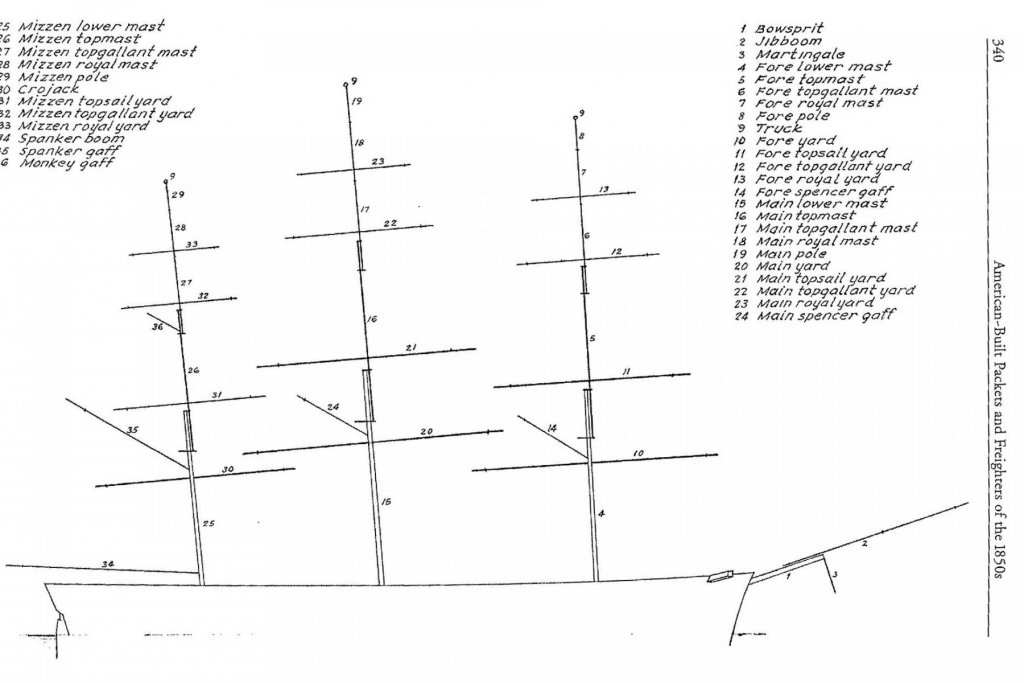 Ap-50 this scan from the Crothers Book shows the basic consensus design of a an American merchant ship of the time. The chapter goes to explain the influence first of Captain Robert Bennett Forbes. The evolution of then top sails grew, due to their power, to be 60 feet wide and high. They drew well but in any wet weather became unmanageable. He was the first to split them in 1844. Part of his experiment was to “fid” the top mast "abaft" of the lower mast. He felt this approach improved the sailing function. Another fun fact is it was he who first popularized these topsails as Gallants in his pamphlets.
Ap-50 this scan from the Crothers Book shows the basic consensus design of a an American merchant ship of the time. The chapter goes to explain the influence first of Captain Robert Bennett Forbes. The evolution of then top sails grew, due to their power, to be 60 feet wide and high. They drew well but in any wet weather became unmanageable. He was the first to split them in 1844. Part of his experiment was to “fid” the top mast "abaft" of the lower mast. He felt this approach improved the sailing function. Another fun fact is it was he who first popularized these topsails as Gallants in his pamphlets.
In the 1850’s Forbes design was much debated. It was a ship builder/ captain named Frederic Howe who while building the clippership Climax in Medford, Ma., made two improvements. He realigned the huge top sail yard and fixed it to the cap of the lower mast. The sail was shorter. He then had a new upper top sail yard hung on the top mast and extended it clew past and behind of the lower yard , filling the previous gap in these two sails. Looking into more clipper ship plans I find this upper yard became known as the top gallant yard as per the Forbes pamphlets.
This is all fun, but for our build we have to respect that Alma was not shown to have any of these newer rigs.
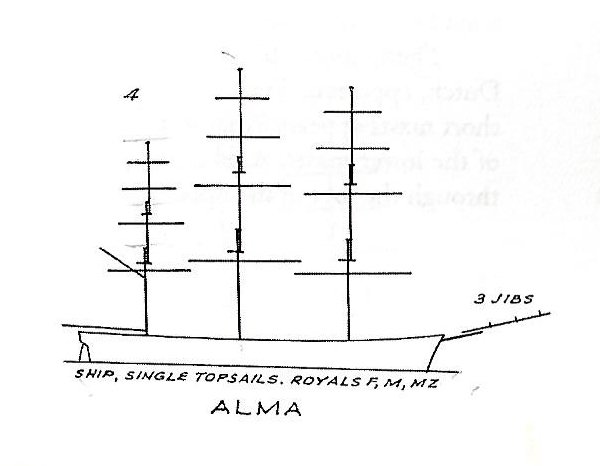 Ap-52 this scan from Crothers book shows the understood rig of Alma that I shall use for the contemporary Maine built ship.
Ap-52 this scan from Crothers book shows the understood rig of Alma that I shall use for the contemporary Maine built ship.
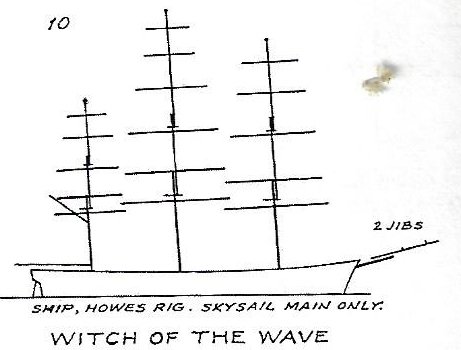 ap-52 scan from Crothers book shows the Forbes Howe change on a clipper of the time
ap-52 scan from Crothers book shows the Forbes Howe change on a clipper of the time
That is all good stuff, but we need to move on to our build and check the existing model by measuring it against the designs of the time..
The measurements
The first job was to take the scan above in ap51 and measure the components. I then measure the hull to get a scaling factor to bring them up to the model scale of 1:96.
The second job was to measure the model components. One yard, the boom and gaff are missing, and one yard is clearly broken. The mast tops were all made and glued and I hope not to damage all of that. I will save that for possible use. { maybe} So, this post is for the planning of the reconditioning.
I have a full excel sheet where I take the Crothers dimensions and’ scale them. Against each number I post the measurement for the existing spar. I won’t post all that here but the results as a list were amazingly good.
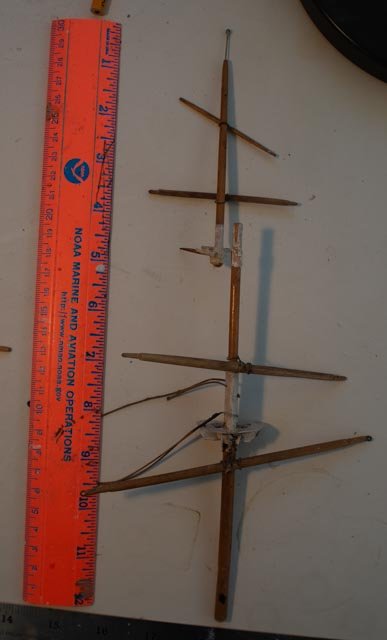 Ap-053 Here we see the foremast . The lower mast is crocked with a splice and it is obvious looking at this photo, I have to disassemble the masts to install the standing rigging…….
Ap-053 Here we see the foremast . The lower mast is crocked with a splice and it is obvious looking at this photo, I have to disassemble the masts to install the standing rigging…….
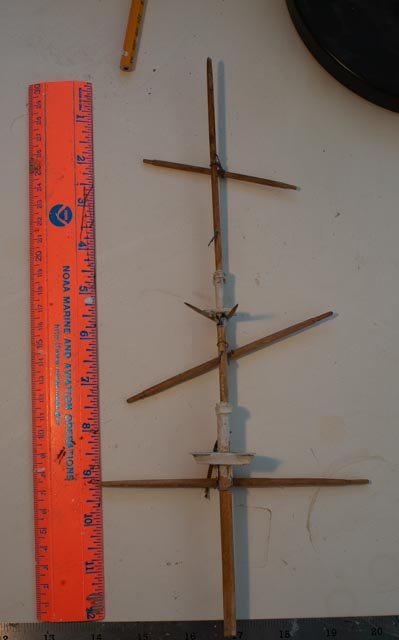 Ap-054 here is the Main mast. It is overall about ½ low. Lower mast needs to be increased in length by 1.25. [definitely replace]. Top gallant mast to be lowered about ¾ inch.
Ap-054 here is the Main mast. It is overall about ½ low. Lower mast needs to be increased in length by 1.25. [definitely replace]. Top gallant mast to be lowered about ¾ inch.
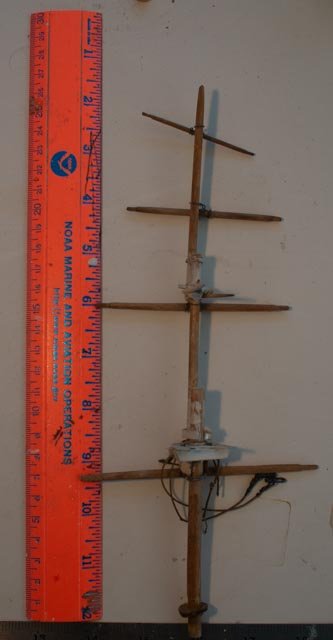 Ap-055 Mizzen masts….very close over all variation about 1/8…clean and reusable…..maybe???
Ap-055 Mizzen masts….very close over all variation about 1/8…clean and reusable…..maybe???
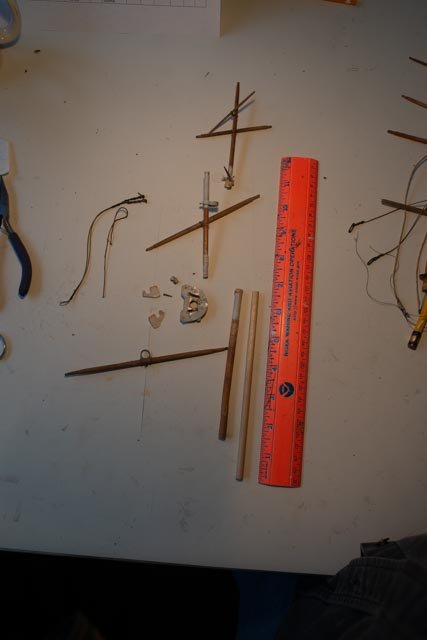 Ap-056 here I have disassembled the fore mast. ….if the 30 inch diameter mast was composite, does a simple dowel reflect how it was made. I must really think about this one.
Ap-056 here I have disassembled the fore mast. ….if the 30 inch diameter mast was composite, does a simple dowel reflect how it was made. I must really think about this one.
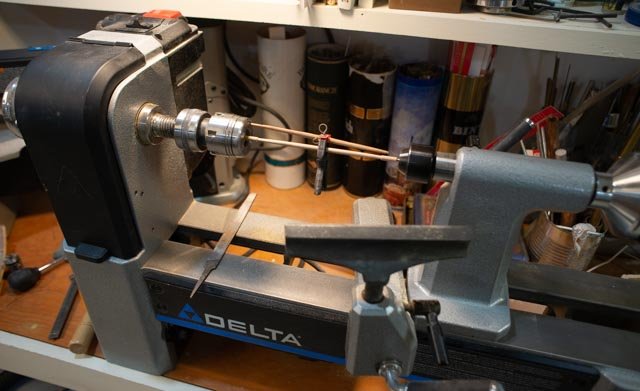 Ap-057 here I am making the missing yard. As to the measurements, the model yards were consistently a bit longer. The shoulder and tips were quite visible, so I may work to reduce that a bit
Ap-057 here I am making the missing yard. As to the measurements, the model yards were consistently a bit longer. The shoulder and tips were quite visible, so I may work to reduce that a bit
There is more study to be had. One reason is I am reading in the Flying Cloud documents so I can best assist a friend on the model, I am finding 30-inch masts were composites with bands and all kinds of things. More of that in another post because I am quickly sliding down a rabbit hole.
I just ordered Crothers Book on masting. $$ again. I am glad it is the journey. At least the book shelf will look good.
Cheers
jon
-
-
Post 7
Upper bulkhead shear planks and rails part 1
It is time to rectify the bulwarks and see that what we end up with is close enough to show the real thing. I started off by reading the chapters on the related items. In summary let’s look at two sketches
-
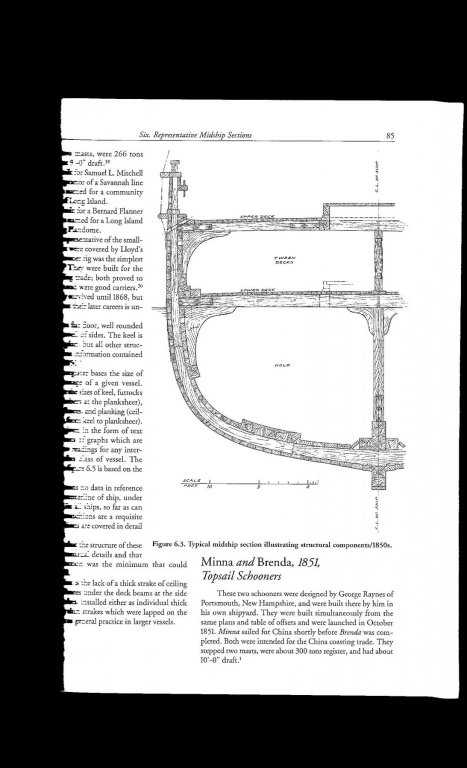 Ap-40 This page, from Crothers’s book, shows the midsection of the hull. What I am after is the relationship on the side from waterline to monkey rail. By taking measurements from the drawing and scaling them slightly to fit the model, we find the issue I have mentioned of the deck being a little high. Not enough at say 1/16” to worry about.
Ap-40 This page, from Crothers’s book, shows the midsection of the hull. What I am after is the relationship on the side from waterline to monkey rail. By taking measurements from the drawing and scaling them slightly to fit the model, we find the issue I have mentioned of the deck being a little high. Not enough at say 1/16” to worry about.
-
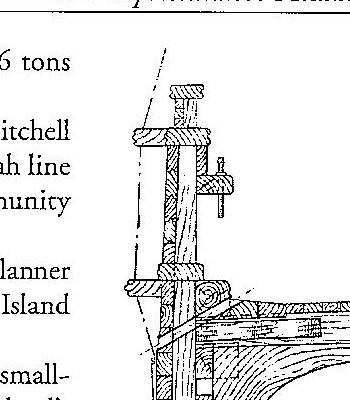 Ap 41 This view is the cropped bulwark for my planning. Here we see that above the pin rail there is an inner plank over the top of the stanchions [ bulwark clamp in nomenclature]. This made my use of a solid horizontal strip in this section show both dimensional separation of the pin rails and provide more solidity to the construction of the model. My next activity will be to build up the monkey rail. As per Crothers index of ships, we are trying to get to 4’-6”or 9/16” to copy information on Alna I will get to ½” due to the slightly high deck to focsle deck, so that is close enough for me especially as the dimension is a bit of conjecture.
Ap 41 This view is the cropped bulwark for my planning. Here we see that above the pin rail there is an inner plank over the top of the stanchions [ bulwark clamp in nomenclature]. This made my use of a solid horizontal strip in this section show both dimensional separation of the pin rails and provide more solidity to the construction of the model. My next activity will be to build up the monkey rail. As per Crothers index of ships, we are trying to get to 4’-6”or 9/16” to copy information on Alna I will get to ½” due to the slightly high deck to focsle deck, so that is close enough for me especially as the dimension is a bit of conjecture.
-
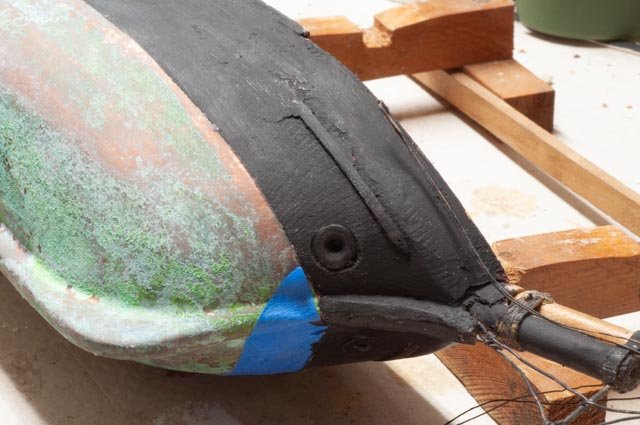 Ap-42 the shear plank is an extension of the main deck elevation and should thus be the ½ inch below the top of the top rail. In this photo we see the remnant of the old shear plank first too wide at 1/8” and too low. I have since carved it off and shall install a proper 1/16 strip at the right height. This also reinforces the previous decision to remove and replace the channels that were at the same level as this rail.
Ap-42 the shear plank is an extension of the main deck elevation and should thus be the ½ inch below the top of the top rail. In this photo we see the remnant of the old shear plank first too wide at 1/8” and too low. I have since carved it off and shall install a proper 1/16 strip at the right height. This also reinforces the previous decision to remove and replace the channels that were at the same level as this rail.
-
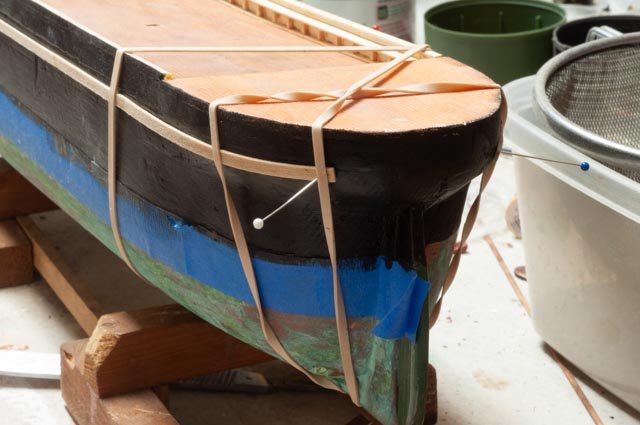 Ap-43 Here we have an issue. This is the soaked future monkey rail stanchion that I set at the plank shear elevation to check out the problem of the too rounded stern. If I had cut out one inch fore and aft and ½ down, replaced it with a block and carved the stern, I could have earned a few more broom handles but ended up with a more proper termination of the shear plank. I will solve this one later
Ap-43 Here we have an issue. This is the soaked future monkey rail stanchion that I set at the plank shear elevation to check out the problem of the too rounded stern. If I had cut out one inch fore and aft and ½ down, replaced it with a block and carved the stern, I could have earned a few more broom handles but ended up with a more proper termination of the shear plank. I will solve this one later
-
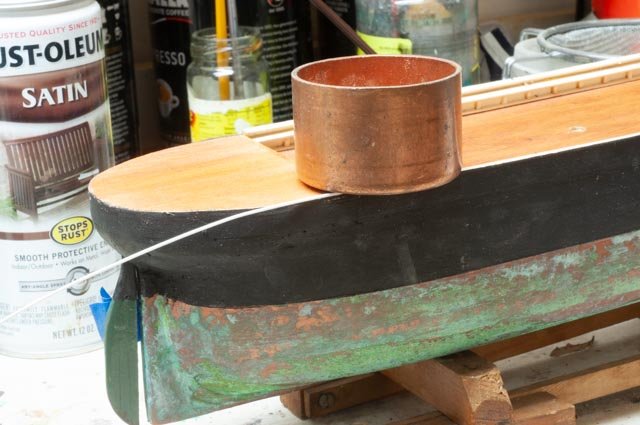 Ap-44 here we see the first of three rings of styrene 30x30 to form the extreme curved water way. This is a short cut for this type model where everything is painted out. I would other wise have cut out the waterway from wider strips. I hope I am forgiven.
Ap-44 here we see the first of three rings of styrene 30x30 to form the extreme curved water way. This is a short cut for this type model where everything is painted out. I would other wise have cut out the waterway from wider strips. I hope I am forgiven.
-
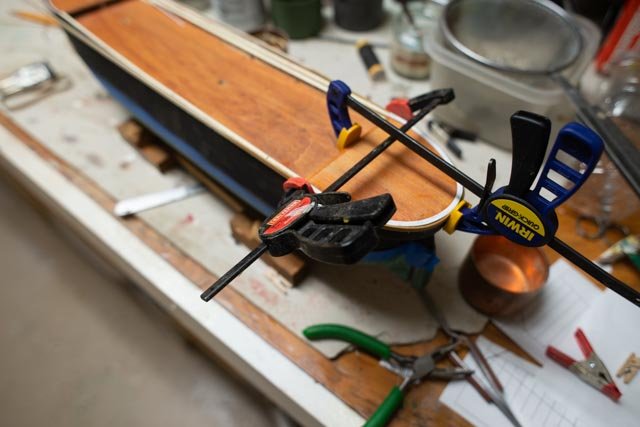 Ap-45 I glue a little bit then bend a little more and work around the waterway. The first outer one is hard, and the inner ones are easier. At the same time, we have the wet future monkey rail stanchion bending to conform to the stern.
Ap-45 I glue a little bit then bend a little more and work around the waterway. The first outer one is hard, and the inner ones are easier. At the same time, we have the wet future monkey rail stanchion bending to conform to the stern.
-
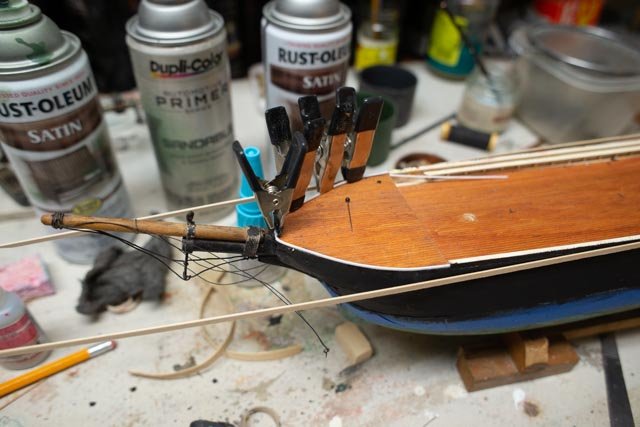 Ap-46 here we are on the focsle deck. There is a sharp bend at the bow. We also have the monkey rail stanchion waiting for the stern to take shape.
Ap-46 here we are on the focsle deck. There is a sharp bend at the bow. We also have the monkey rail stanchion waiting for the stern to take shape.
-
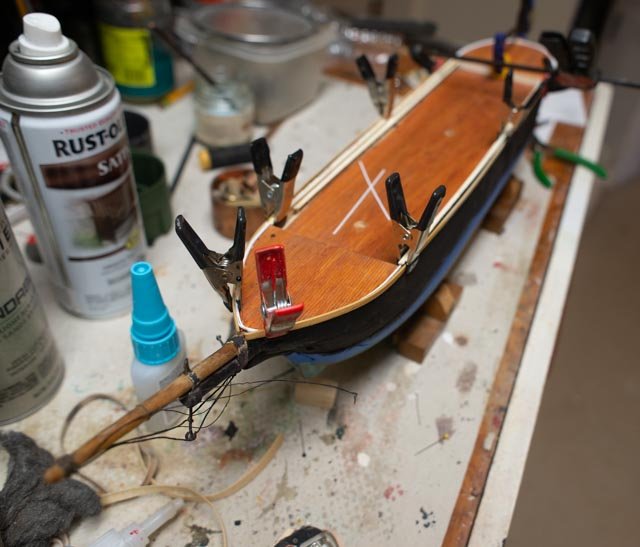 Ap-47 Here we continue by cutting to rough length, presoaking the bow section of the monkey rail stanchion, and bending them to conform.
Ap-47 Here we continue by cutting to rough length, presoaking the bow section of the monkey rail stanchion, and bending them to conform.
-
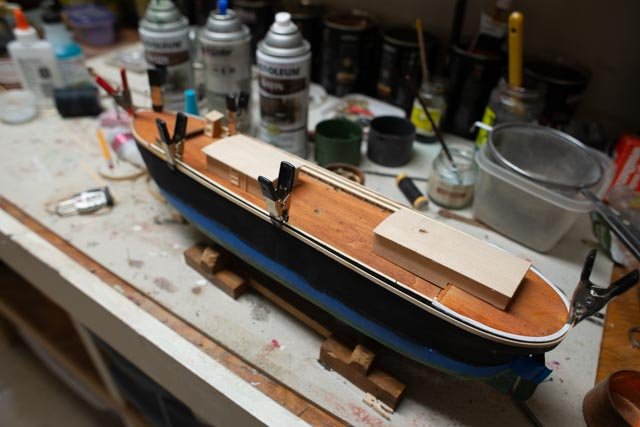 Ap-48 Just for fun, I have some progress on the deck houses, and it is fun to see how were coming along.
Ap-48 Just for fun, I have some progress on the deck houses, and it is fun to see how were coming along.
-
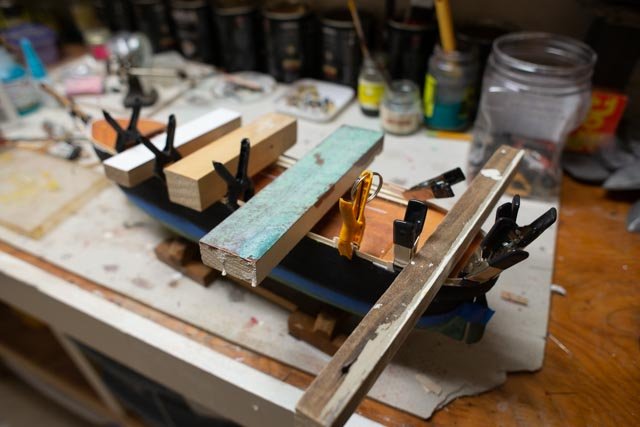 Ap 49 Here we are gluing the first aft section of the monkey rail stanchion. I am using scrap shims to hold it to the center of the main rail, the bow or stern water way.
Ap 49 Here we are gluing the first aft section of the monkey rail stanchion. I am using scrap shims to hold it to the center of the main rail, the bow or stern water way.
We are away for a while and spring is coming, I just want to get the bulwarks and main houses done before the slow down for summer.
I am still working on the other projects with summer dead lines. this model is for next summer
Cheers
Jon
-
-
Keith
It is such a joy to sit down with a cup of coffee and read the next few pages of your build. I just learned all about options to finish wood at this scale , to turn portholes and to punch acrylic so they look real. This last image showing the hull should make the team rooting for paint pause.....if only briefly. It is gorgeous. I can't wait to find out what you decide to do.
Jon
- Chasseur and Keith Black
-
 2
2
-
Mark
Thankyou for the tip. I typed in U S Constitution in dry dock and got dozens of photos. They show several variations. What is interesting is they are the opposite of my results. The inside curve near the stern had large areas where the copper color stayed. Perhaps movement of water. On the other hand, the U S Constitution does not move very much so what that might mean is out there.
The process of seeing them makes me feel better. To the real modeler I may have strayed into folk-art, but I am ok with that.
Cheers
Jon
-
-
Post 6
Copper Hull experiment…the patina part 2
I think I ‘m going to proceed. I can always come back and change. Here is my rationalization.
-
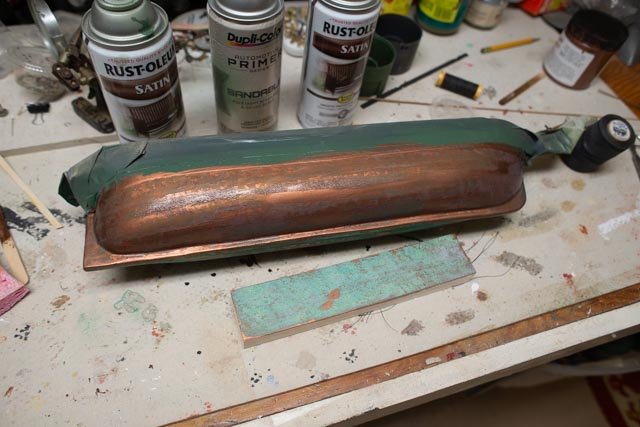 Ap-33 I turned her around and tried the other side. This image shows we are on side two with coat two ready for treatment.
Ap-33 I turned her around and tried the other side. This image shows we are on side two with coat two ready for treatment.
-
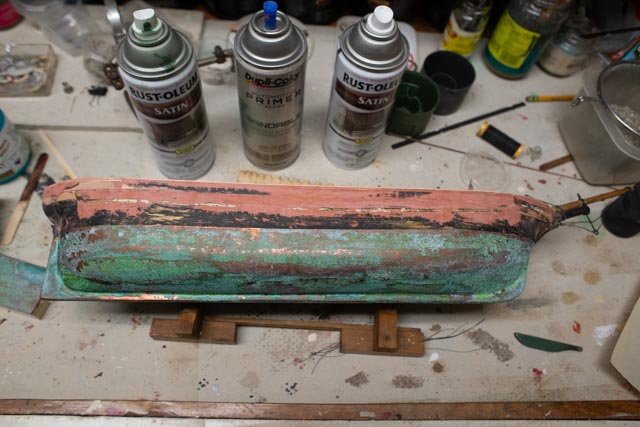 Ap-34 here we have the same issue as the other side. I only did two coats so three coats as an issue is eliminated. I was very careful on application, and the bare spots still came up. They are consistent on the roundest part. Before removing the masking tape, I did a second application. There is improvement but some green is getting too green.
Ap-34 here we have the same issue as the other side. I only did two coats so three coats as an issue is eliminated. I was very careful on application, and the bare spots still came up. They are consistent on the roundest part. Before removing the masking tape, I did a second application. There is improvement but some green is getting too green.
-
 Ap-35 another issue is which black to use. I started with this coat as an experiment. It needs another cycle of filler sanding and another coat anyway. This trial is the ink black that is so perfect for flat iron work. It is flat, I mean really flat. The debate is ..was paint in 1853 ink black or oil and other pigment. Should one use flat or satin. I just don’t know the evolution of paint. If tar it is a bit shinny and I like to use ebony stain for that of ratline slats and things. All the books say is black. I will do each side different and then decide.
Ap-35 another issue is which black to use. I started with this coat as an experiment. It needs another cycle of filler sanding and another coat anyway. This trial is the ink black that is so perfect for flat iron work. It is flat, I mean really flat. The debate is ..was paint in 1853 ink black or oil and other pigment. Should one use flat or satin. I just don’t know the evolution of paint. If tar it is a bit shinny and I like to use ebony stain for that of ratline slats and things. All the books say is black. I will do each side different and then decide.
As to the look …….I mean when the model will be displayed how does this patina and paint look…
-
 Ap36…This image fairly shows it will be low and not under bright light on the lower hull.
Ap36…This image fairly shows it will be low and not under bright light on the lower hull.
As to the message…. I am trying to depict what things were, how they worked and focus more on that. I am not the fine workmen to focus on the beauty of the wood or the skill in finish and carving and the like.
-
 Ap37 a glance of the hull at eye level as one walks by… I want one to look at the model and sure like what they see, but also understand from the glance what things are made of. That bottom says I AM MADE OF COPPER AND I TURNED MOSTLY GREEN. The green paint did not.
Ap37 a glance of the hull at eye level as one walks by… I want one to look at the model and sure like what they see, but also understand from the glance what things are made of. That bottom says I AM MADE OF COPPER AND I TURNED MOSTLY GREEN. The green paint did not.
-
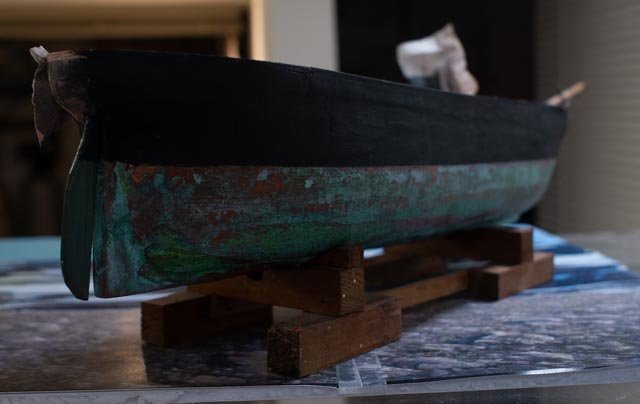 Ap 38… I have read the copper plates under water did not change to all the same green. The copper near the water line that saw air was the greenest, some boats saw more time in dry dock, Some areas where fast water kept the copper hue longer[ maybe??]. All these things are perceptions. And we have no copper in our lifetime to look at.
Ap 38… I have read the copper plates under water did not change to all the same green. The copper near the water line that saw air was the greenest, some boats saw more time in dry dock, Some areas where fast water kept the copper hue longer[ maybe??]. All these things are perceptions. And we have no copper in our lifetime to look at.
-
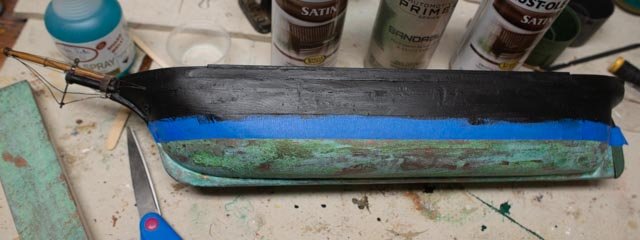 Ap-39 I went ahead and painted the opposite side with the satin finish black. In the write ups on 1850 paint, Crothers discusses the mix of ink black with red lead and “paint Oil” [ other reference said linseed oil]. If they were painting yards black, they added turpentine to the brew as it... "gave a gloss". [ Therefore, without adding turpentine it may have been flat. I have a different issue. This hull is caved spruce. Despite three treatments of putty and sanding the satin finish highlights every little defect and takes the eye the wrong way as to scale. The spruce grain that I have filled and sanded three times is still there and ruins the concept that one inch of model is eight feet in life. On the flat iron side, there are defects that I can eliminate with another round of fill sand and paint to the result of the back ground is non discernible. That is the look I need for this repair. Once I replace the plank sheer and the channels, I want them to be what is seen not the grain that despite my effort lives on.
Ap-39 I went ahead and painted the opposite side with the satin finish black. In the write ups on 1850 paint, Crothers discusses the mix of ink black with red lead and “paint Oil” [ other reference said linseed oil]. If they were painting yards black, they added turpentine to the brew as it... "gave a gloss". [ Therefore, without adding turpentine it may have been flat. I have a different issue. This hull is caved spruce. Despite three treatments of putty and sanding the satin finish highlights every little defect and takes the eye the wrong way as to scale. The spruce grain that I have filled and sanded three times is still there and ruins the concept that one inch of model is eight feet in life. On the flat iron side, there are defects that I can eliminate with another round of fill sand and paint to the result of the back ground is non discernible. That is the look I need for this repair. Once I replace the plank sheer and the channels, I want them to be what is seen not the grain that despite my effort lives on.
Conclusion…that is better said my conclusion
What I have may be out of scale and to some will be awful. Perhaps I should do copper plate and then acid etc. This test shows my attempt to clearly explain the bottom is copper patina. I spent only $40 on material and having used just 10% of it means that supply could do many more models. I feel it is better to use on the larger hulls meant for RC sailing and someday I shall treat my large 1853 Pilot schooner, I showed in the last posting, that is currently just green paint. I have a friend building a 6-foot Flying Cloud and maybe he will like it. I believe the results are better than green spray paint. ..The option to install thin Copper plates to this hull would have been easily $100++. The market plates are meant, I believe, for larger scale 3/16" and up, so I am not sure what to do. Then I still would have the issue of how to treat to get patina. As to scale with the tape option…..would one punch the nail holes at 1:96? I think not……and unpunched tape just is not worth the effort to prepare the hull.
Regardless there is always so much to learn. Years from now, I may laugh at this conclusion. This model is not a fine piece to have any great value. It is chance to salvage an old model and end up with a decent replication of a ship built at the time, so people can see what was built in our harbor.
With that logic or at least opinion, it is time for me to move forward. I will do more touch up on the Dixie Bell copper, as handling will cause some damage and I need to address the “too green” spots. I also need to do the rudder. I tried sanding with 400 grit, and it improved the look by removing the roughness and blending colors some. That helped reduce the scale issue. I will use the Ink Black super flat paint for the hull and then a satin when I get to the painted yards. I will re address this when we are really done with the hull.
on to the bulk head
Cheers
- GrandpaPhil, KeithAug, Tom E and 1 other
-
 4
4
-
-
Posting 5
Copper hull experiment
I always like to try something new. It does not always work. I am setting myself up for big oops, so let’s follow the bouncing ball, as I attempt a craft approach to copper patina paint.
-
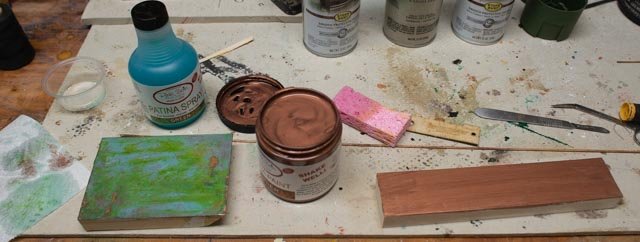 Ap-25 the secret supplies arrive. On the net I found many choices but was most intrigued with the Dixie Bell paint procedures. Here I have chosen the copper patina paint [ in the jar] and the green [ vs optional blue] patina spray. They show applications to vary from the spray to sponge.
Ap-25 the secret supplies arrive. On the net I found many choices but was most intrigued with the Dixie Bell paint procedures. Here I have chosen the copper patina paint [ in the jar] and the green [ vs optional blue] patina spray. They show applications to vary from the spray to sponge.
The sample on the left I did not like. It was too much liquid which over treated the paint and retained a chartreuse green. On the right we have the second sample. One paints a copper layer and lets it dry. One then applys a second coat and added the liquid to the wet paint so like blackening agent for copper and brass fittings, the metal particles suspended in the still wet paint can turn color.
-
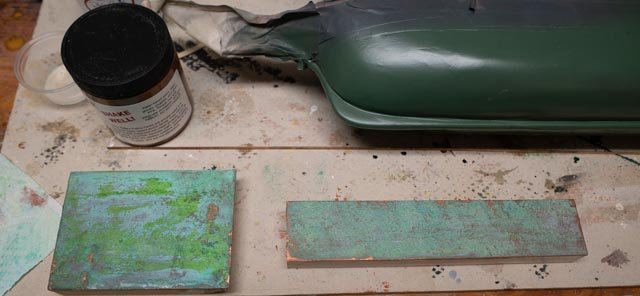 Ap-26 here the second sample looks ok
Ap-26 here the second sample looks ok
-
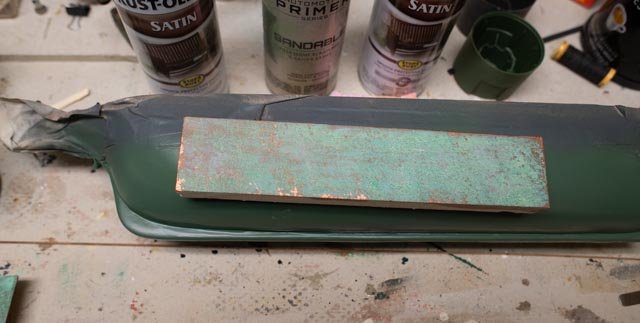 Ap-27 the test. Setting the second sample over the green hull I decide to go for it.
Ap-27 the test. Setting the second sample over the green hull I decide to go for it.
-
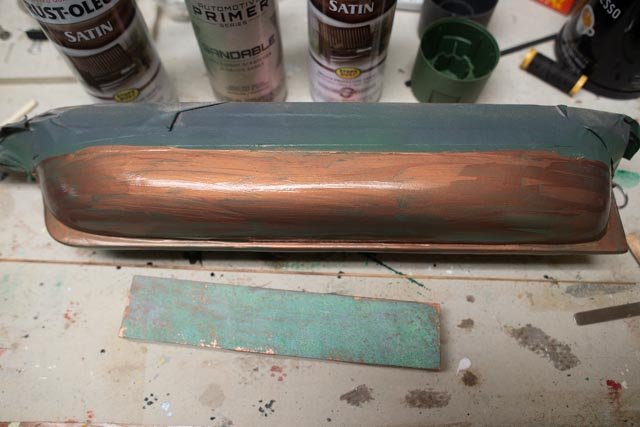 Ap-28 first coat per instructions….let it dry
Ap-28 first coat per instructions….let it dry
-
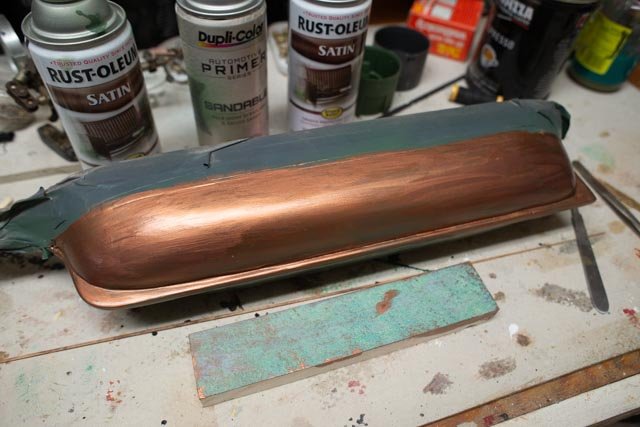 Ap 29 I was not satisfied with the cover of one coat over the green so I added a second coat….maybe oops.
Ap 29 I was not satisfied with the cover of one coat over the green so I added a second coat….maybe oops.
-
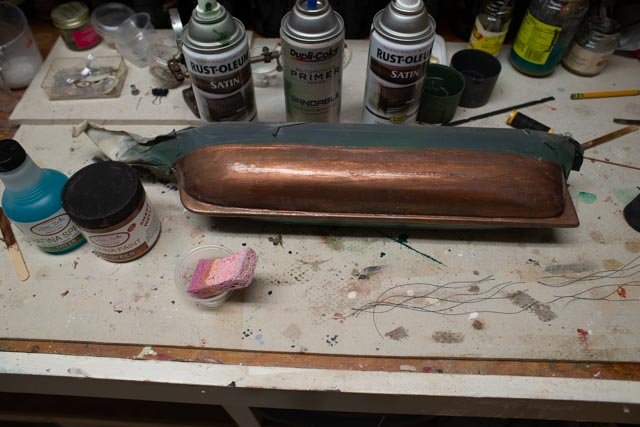 Ap-30 Here as the third wet coat gets sponged, I am optimistic!
Ap-30 Here as the third wet coat gets sponged, I am optimistic!
-
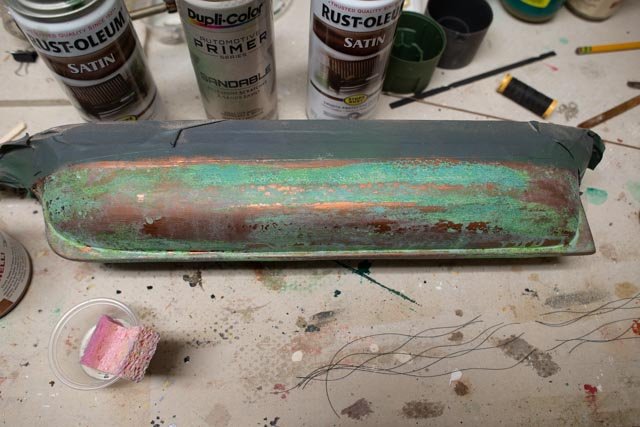 Ap 31 hours later I am perplexed. Why so different than the flat surface. This may be great results for life size plaster bust that I want to look like old brass but for the scale it may be wrong.
Ap 31 hours later I am perplexed. Why so different than the flat surface. This may be great results for life size plaster bust that I want to look like old brass but for the scale it may be wrong.
-
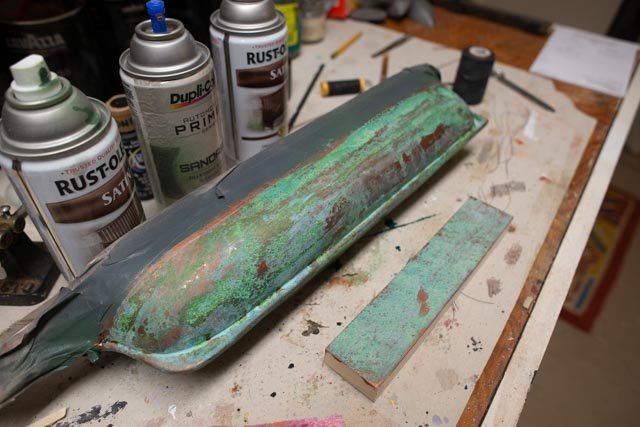 Ap-32 here if you compare closely I have put dabs on where the copper showed the most and added more treatment. It’s better but the green if hit twice seems to get too green. What to do.
Ap-32 here if you compare closely I have put dabs on where the copper showed the most and added more treatment. It’s better but the green if hit twice seems to get too green. What to do.
Stand by I am trying side two
Jon
- GrandpaPhil, Mirabell61, Tom E and 3 others
-
 6
6
-
-
Thank you Keith
Now I am ready for some real comments on my next two posts.
-
Post 4
Hull part 2
Ok it is time to move under water line. This carved hull of spruce had large grain, two knots etc. That is fine if I strip it and varnish it as a novelty. I am trying however to depict what a ship was like that was indeed build here, and not what the model is made o. Therefore a crisper cleaner look is needed in this area. The process is routine, the issue becomes do we do three times through or keep going. How are we going to depict the copper?
-
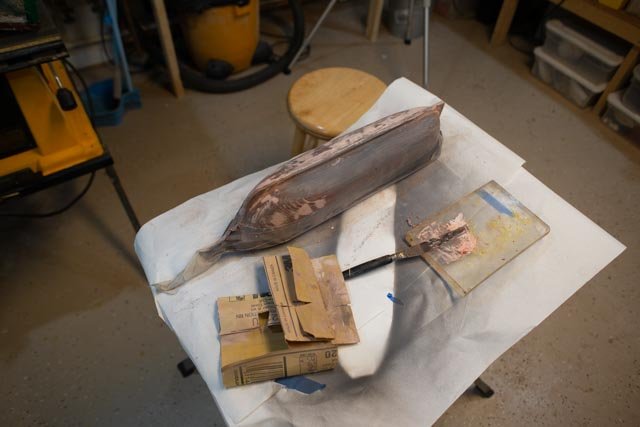 Ap-018 this view is after the first full cycle of bondo, sand 220 grit, putty, sand prime and sand 400.
Ap-018 this view is after the first full cycle of bondo, sand 220 grit, putty, sand prime and sand 400.
-
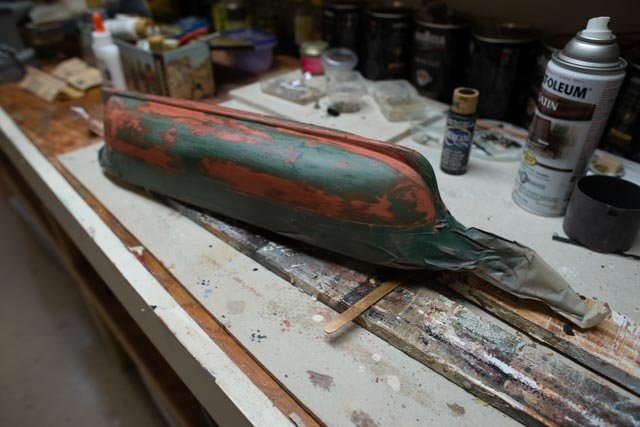 Ap-019 second time we delete bondo and go with smoother glazing putty. Then gray auto filler primer. Sand that 400 grit and spray the green finish. Now we add more glazing putty and sand…yes a mess but we all know it well.
Ap-019 second time we delete bondo and go with smoother glazing putty. Then gray auto filler primer. Sand that 400 grit and spray the green finish. Now we add more glazing putty and sand…yes a mess but we all know it well.
-
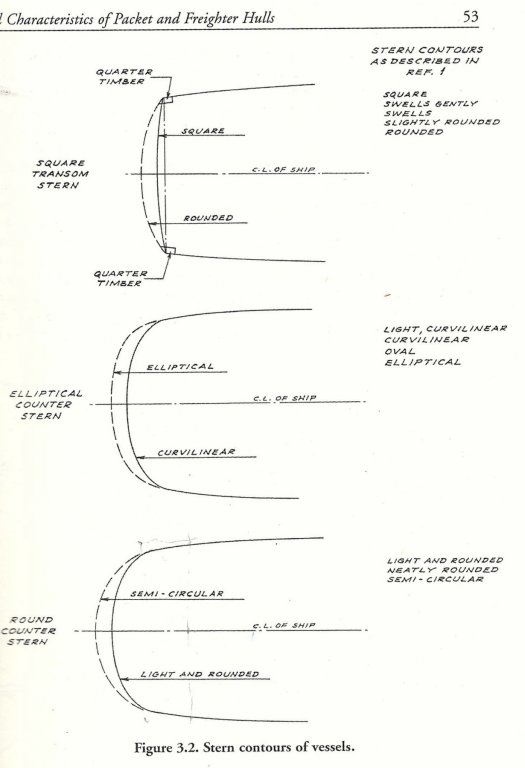 Ap-020 the transom. Here is the discussion on different transoms at the time. Alna was the bottom one, Lightly rounded as per this scan from Crothers book. Well our model is defiantly a semi-circle. Looking back to the photo ap-015 we see that if I cut the transom to the right shape shown as pencil on masking tape, I would uncover the rudder. The other alternative would be to cut out a block and set a larger one in its place. Then I would need to carve the transom to extend cheeks and create the correct “lightly curved” profile. I decided to leave as it is and simply record the finding.
Ap-020 the transom. Here is the discussion on different transoms at the time. Alna was the bottom one, Lightly rounded as per this scan from Crothers book. Well our model is defiantly a semi-circle. Looking back to the photo ap-015 we see that if I cut the transom to the right shape shown as pencil on masking tape, I would uncover the rudder. The other alternative would be to cut out a block and set a larger one in its place. Then I would need to carve the transom to extend cheeks and create the correct “lightly curved” profile. I decided to leave as it is and simply record the finding.
-
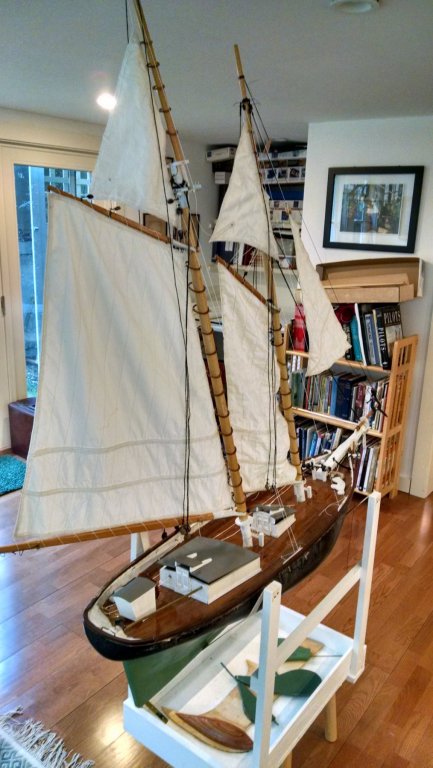 Ap-021 in this photo one sees the first sailing schooner I built. It is large scale and meant more to sail than to replicate any details. I used rattle can soft green paint to replicate the copper bottom. This is my starting point
Ap-021 in this photo one sees the first sailing schooner I built. It is large scale and meant more to sail than to replicate any details. I used rattle can soft green paint to replicate the copper bottom. This is my starting point
-
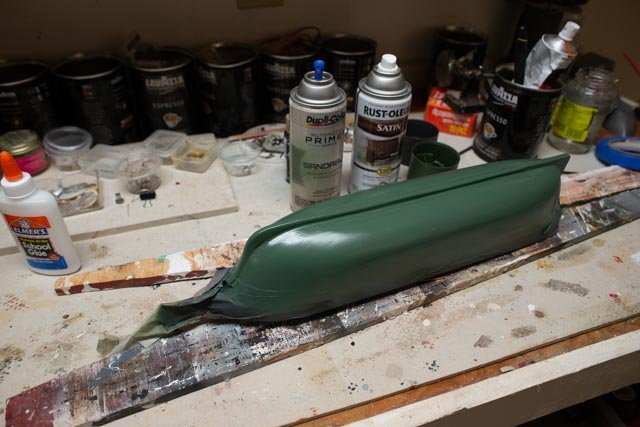 Ap-022 well here we are as we stand if this level is good enough. This is the third green paint cycle of paint and patch and repaint. As a sign, the can ran dry, so perhaps it’s a signal that we reached enough.
Ap-022 well here we are as we stand if this level is good enough. This is the third green paint cycle of paint and patch and repaint. As a sign, the can ran dry, so perhaps it’s a signal that we reached enough.
Stand by because I am going to try an experiment before leaving the process as is [ loose interpretation of patina] material is on its way.
In between coats and other jobs I found a need to rebuilt the standing rigging channels.
-
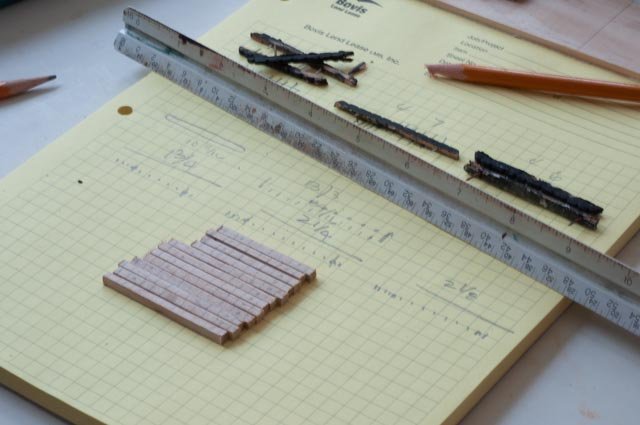 Ap-023 Here I use the mini saw to try to make them the same length. I found some scrap hard wood similar in color to maple. I find bass wood to"frayey" if there is such a word for this type work. I have a big block of pear someone gave me to mill down but that is a winter project in itself.
Ap-023 Here I use the mini saw to try to make them the same length. I found some scrap hard wood similar in color to maple. I find bass wood to"frayey" if there is such a word for this type work. I have a big block of pear someone gave me to mill down but that is a winter project in itself.
-
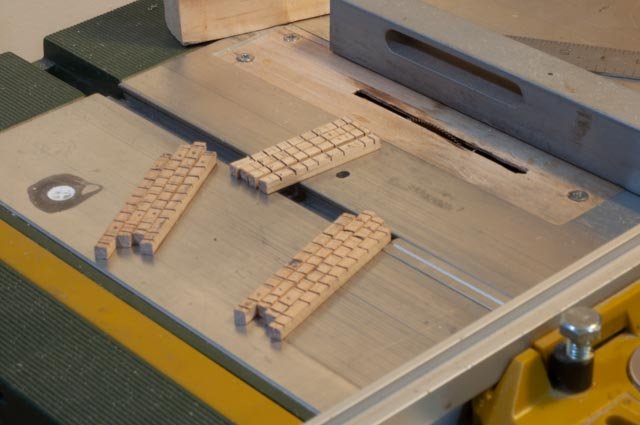 Ap-024 here I sliced out the groves, again to make them look a like. After this step, they were filed with triangle to get to a groove. I chose to make the lengths and slices based on the Crothers plan which was a little different that the old model. i will be doing the standing rigging on this plan so the groove count will match up.
Ap-024 here I sliced out the groves, again to make them look a like. After this step, they were filed with triangle to get to a groove. I chose to make the lengths and slices based on the Crothers plan which was a little different that the old model. i will be doing the standing rigging on this plan so the groove count will match up.
Cheers
Jon
- mtaylor, GrandpaPhil, KeithAug and 2 others
-
 5
5
-
-
Post 3
How about those channels
I studied the drawings for building the bulkheads and pin rails. First up I decided was to cut and place the stanchions. Because of the tight scale, I decided to cut them short [3/16”] to come under the pin rail. I then added a 1/16” x 1/16” strip to increase the height properly to the main rail. I want the main rail to end and tied to the waterway on both the focsle deck and half poop deck to follow the Crothers drawing. I have some compromises here. As I said before the focsle is a good 1/16"+ low and I chose not to raise it. I am trying to replicate 4’6” total rail as per Alna but I won’t quite get there. We’ll see.
-
 Ap-011 here we are holding down the main rails for the shear.
Ap-011 here we are holding down the main rails for the shear.
-
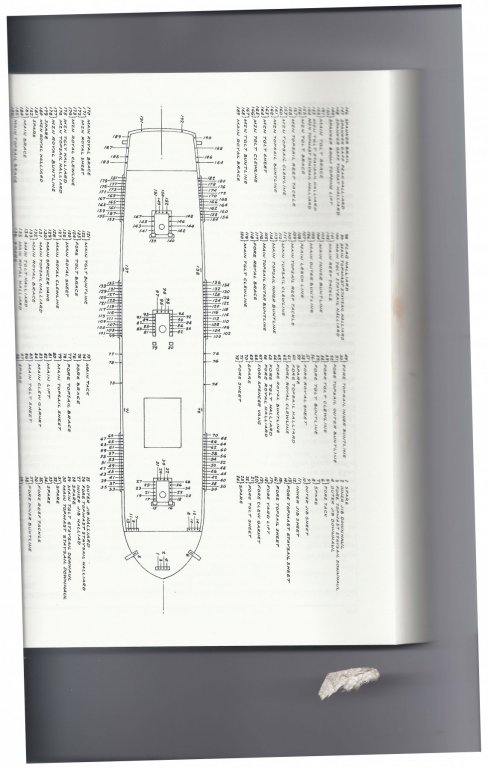 Ap-011a I scanned this page for Crothers book just to show the slippery slope of models ships. This is the pin layout and there are 198 pins…….OK maybe on the next one.
Ap-011a I scanned this page for Crothers book just to show the slippery slope of models ships. This is the pin layout and there are 198 pins…….OK maybe on the next one.
-
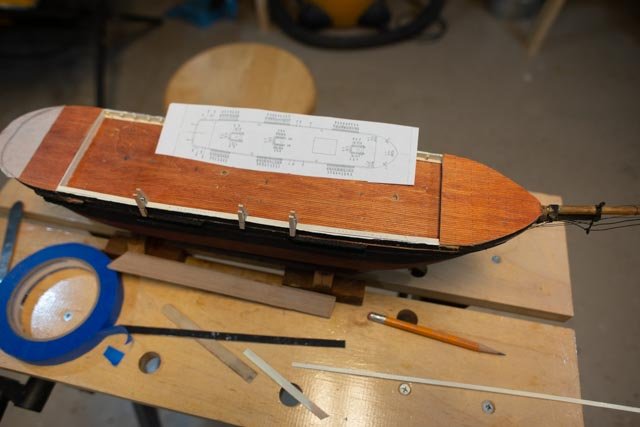 Ap-012 I cut it out and looked to see how the existing channels are located. Surprisingly after finding he masts correct, I was surprised to see how poorly they are located.
Ap-012 I cut it out and looked to see how the existing channels are located. Surprisingly after finding he masts correct, I was surprised to see how poorly they are located.
-
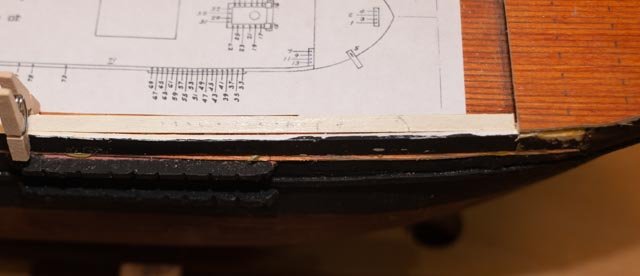 Ap-013 Here is the foremast. I have light pencil lines where the pins go, and the channel location is way off.
Ap-013 Here is the foremast. I have light pencil lines where the pins go, and the channel location is way off.
-
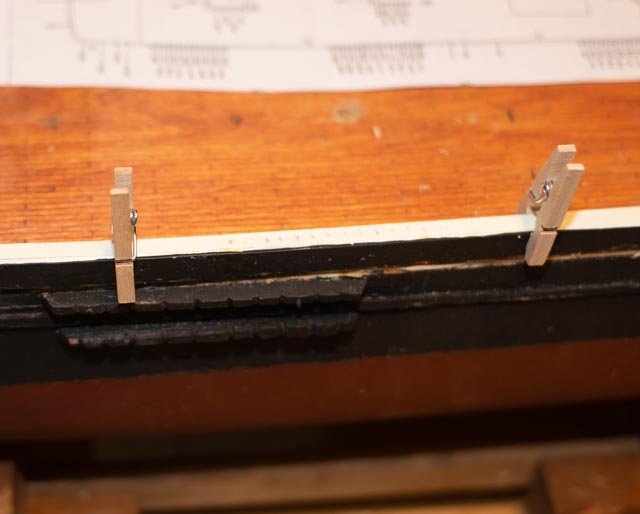 Ap-014 Here on the main mast we see they are off and awful looking I am happy I get to replace them as it will make fixing up the hull much easier than to try to work around them.
Ap-014 Here on the main mast we see they are off and awful looking I am happy I get to replace them as it will make fixing up the hull much easier than to try to work around them.
-
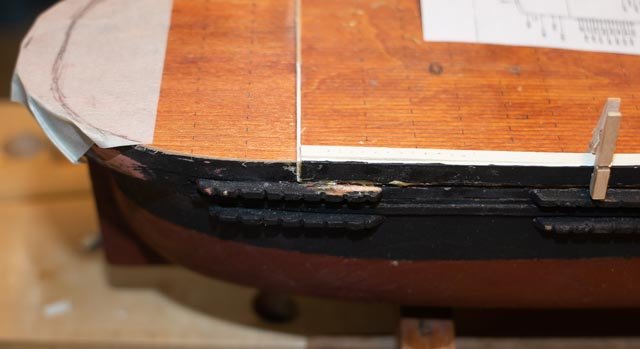 Ap-015 here is the mizzen. I also found I need to raise the half poop deck to meet the main rail 1/16". I like this as there was small damage to the first applied deck sheet. The tape and pencil line on the transom I will discuss in the next posting; they represent the proper shape of the stern.
Ap-015 here is the mizzen. I also found I need to raise the half poop deck to meet the main rail 1/16". I like this as there was small damage to the first applied deck sheet. The tape and pencil line on the transom I will discuss in the next posting; they represent the proper shape of the stern.
-
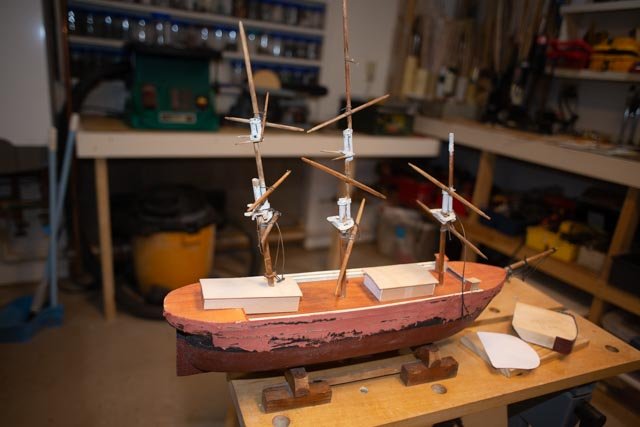 Ap-016 So for fun here I have stuck the old masts in to take a look. I have started the hull rebuilding above the water line. About three times through the filler, sand and cleaning process. I want to get this done before working below the water line, but also before the more delicate monkey rails.
Ap-016 So for fun here I have stuck the old masts in to take a look. I have started the hull rebuilding above the water line. About three times through the filler, sand and cleaning process. I want to get this done before working below the water line, but also before the more delicate monkey rails.
- I need to think about how much rigging so I can plan on pins. I assume at this small scale they are about 5/32”… I guess I set up and cut a bunch of coper wire with black coating to contrast with the ivory [ off white] color scheme of the bulkheads.
-
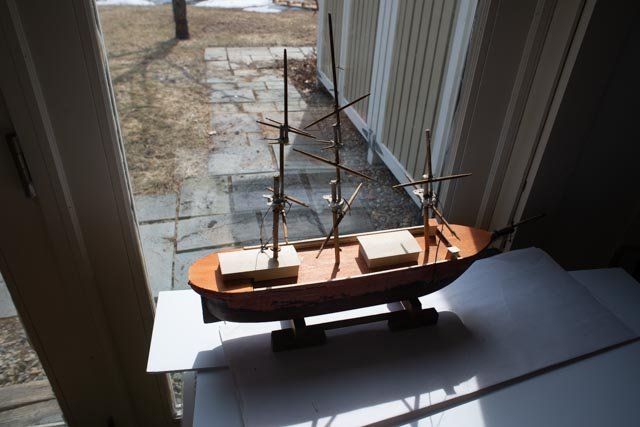 Ap-017 I love to play with side and back lighting when planning a display.
Ap-017 I love to play with side and back lighting when planning a display.
All for now
Cheers
- KeithAug, Mirabell61, GrandpaPhil and 1 other
-
 4
4
-
-
Post 2
The hull part 1
I am feeling my way here so I am not sure how far we may go. There is a lot this hull needs but if I go crazy one might ask….as Roger already did ask…..why am I using this old hull, it seems more work than carving a new one........I can attest Roger is right. So let’s try better to stay with the basics
Easy ones
The red paint must go! Then the decision to add either yellow metal / copper plate as was in vogue according to Crothers on most ships / freighters of the time. He also said that some yards sent them out painted and the owner then added plating and other items in dry dock before her first outing. We shall try to do more research on whether copper was part of the Boothbay Scope, but for now I have no reason not to include it. So for the choices, we will first clean up the rough spruce log look and paint a simple light green to simulate patina copper/ yellow metal [ contained more tin I read]
I will share a fun experiment that I thought I might try when it comes. The teaser! lets look a a little progress on the hull
 Ap-006 So the first thing I did was to cap off the hull with a simple sheet stock decking. I hemmed and hawed about stain colors and ended up with gunstock. A bit too red for some but with sheet stock the grain comes through and blows the scale, so I went dark. I then after one coat of poly added pencil lines on the joints and cut all planks to be 12 feet on three alternating rows. I say all this hoping someone says right or wrong. Please note the added 1/2 poop deck that matched up with e focsle deck on height. The block cut outs are for cladding the deck houses again as per the Alna deck layout plan
Ap-006 So the first thing I did was to cap off the hull with a simple sheet stock decking. I hemmed and hawed about stain colors and ended up with gunstock. A bit too red for some but with sheet stock the grain comes through and blows the scale, so I went dark. I then after one coat of poly added pencil lines on the joints and cut all planks to be 12 feet on three alternating rows. I say all this hoping someone says right or wrong. Please note the added 1/2 poop deck that matched up with e focsle deck on height. The block cut outs are for cladding the deck houses again as per the Alna deck layout plan
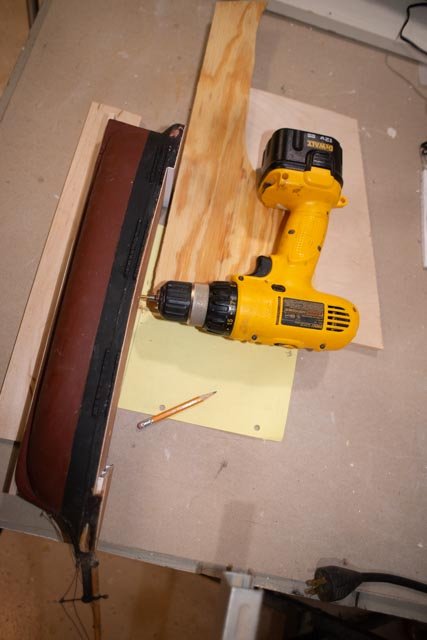 Ap-007 The second thing is to get the masts laid out and drilled. I want to try to reuse the old ones and their methods was a minor countersink [ 1/16”] at full diameter and a pin. Here I laid out the rake per Crothers on the yellow graph paper and aligned/ shimmed the drill and hull to be square for the pin hole.
Ap-007 The second thing is to get the masts laid out and drilled. I want to try to reuse the old ones and their methods was a minor countersink [ 1/16”] at full diameter and a pin. Here I laid out the rake per Crothers on the yellow graph paper and aligned/ shimmed the drill and hull to be square for the pin hole.
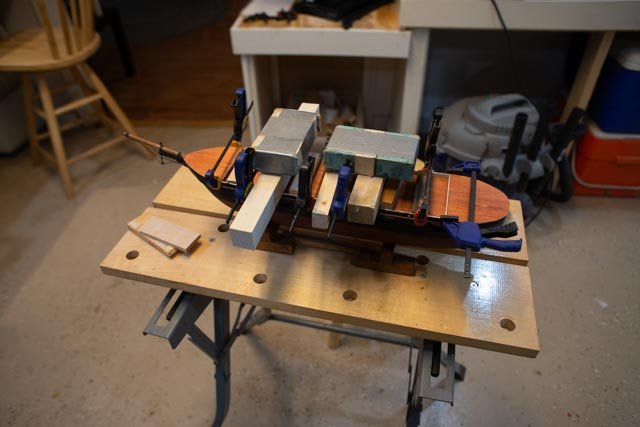 Ap-008 Here is the first bulkhead. It is ¼[ 2 feet] with waterway inboard. That is 1/16 too low but here I am compromising to fit the preordained low focsle deck. More on that later
Ap-008 Here is the first bulkhead. It is ¼[ 2 feet] with waterway inboard. That is 1/16 too low but here I am compromising to fit the preordained low focsle deck. More on that later
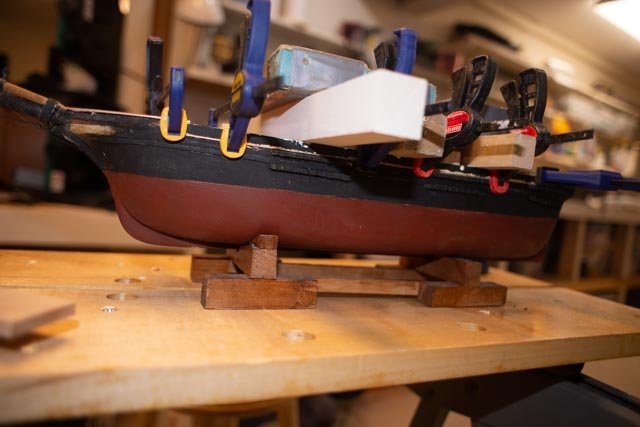 Ap-009 I had to use lead weights to bend the bulkhead to the existing shear. i wanted to get it in place before fixing the hull...that has several problems
Ap-009 I had to use lead weights to bend the bulkhead to the existing shear. i wanted to get it in place before fixing the hull...that has several problems
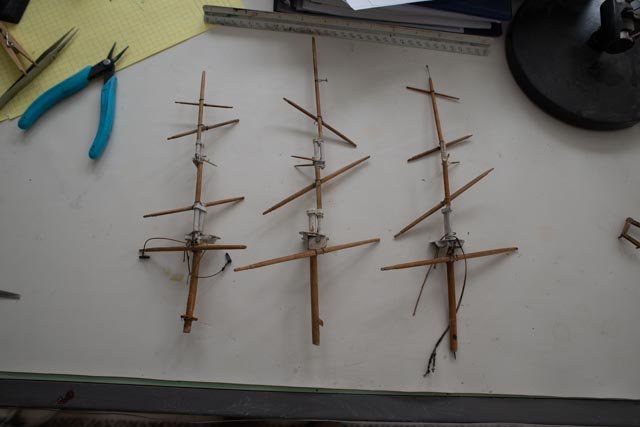 Ap-010 just as an import glance I want to share the existing spars that we need to study. I want to rescue them but there are a few dimensional issues. The good news is when I took Crothers dimensions to locate them, the fore and Main mast feel in the same hole almost perfectly. The mizzen was a bit aft but that makes perfect sense as there was no poop deck on the original model, and the rake of the mizzen mast moves the opening on the poop deck right back to the right place. this is good news.
Ap-010 just as an import glance I want to share the existing spars that we need to study. I want to rescue them but there are a few dimensional issues. The good news is when I took Crothers dimensions to locate them, the fore and Main mast feel in the same hole almost perfectly. The mizzen was a bit aft but that makes perfect sense as there was no poop deck on the original model, and the rake of the mizzen mast moves the opening on the poop deck right back to the right place. this is good news.
All for now
Jon
- GrandpaPhil, Tom E, KeithAug and 3 others
-
 6
6
-
-
Thanks Tim
Bertha Downs is incredible . Please consider buying the very complete book on the anatomy of that wonderful schooner
One might note that more than 10 days to reply shows I have too many irons in the fire.
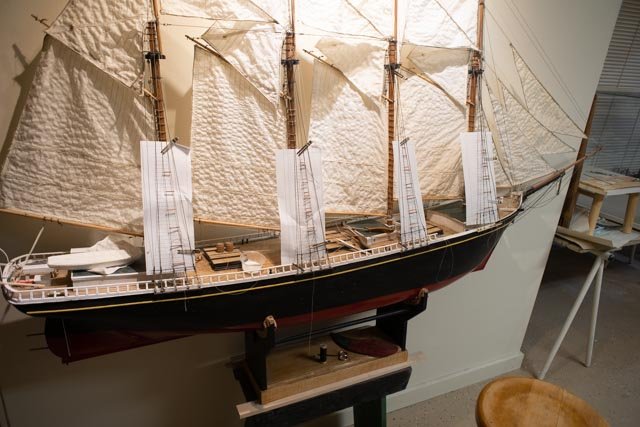 here I am trying to keep a pace of slats per day. i will get there but 15 a day is tough as there are to many o days. I am also fixing up two schooners, and completing the Bowdoin diorama all for may. then I started another ship! i must be nuts...spring clean up is around the corner and we need to get so much done
here I am trying to keep a pace of slats per day. i will get there but 15 a day is tough as there are to many o days. I am also fixing up two schooners, and completing the Bowdoin diorama all for may. then I started another ship! i must be nuts...spring clean up is around the corner and we need to get so much done
cheers
jon
- GrandpaPhil, coxswain, cog and 1 other
-
 4
4
-
Thanks for the comments.
first to Roger.........Thanks for the question because to answer it helps me form my rationalizations and think ahead. This old model was being thrown out by the Maine Maritime Museum. I am trying to give it new life and along with other builds refocusing all to replicate what was built here in Boothbay. I agree that there are several issues with this hull like:
- the shape of the stern. It should be a "round counter stern' per Crothers. I did some minor sanding to reshape to simulate but not yet achieve even a symmetric curve . I am considering using my oscillating belt to also bring in the end to achieve the counter, but it will not be perfect. The rest of the hull however looked good to me other than two bulges at the bow that I knocked down.
- the height of the focsle deck is definitely too low. It is only a few feet up and I believe it should be a bit more. the data says the top of the combined bulkhead should be 4'-6".. I will be pushing the monkey rail to get to 4 feet. I want the main rail to tie into the water way for the upper decks as that seems to be the way in the Crothers drawings. the monkey rail then just flows all around.
- I chose to build up the half poop to match the low focsle, so it comes together in the rails. The cabin I built is therefor also low on the main deck. the correction might have been to carve main deck down, but I felt I am recusing a model and need to relax a bit.
my intent is to openly declare what I determine is wrong. I plan to try to breath new life into he model and help a friend who owns it. I also have much to learn from the build and that is big for me. I will spend a few months learning how to work at a new scale for me 1:96 and to do square rigging. I am truly a schooner guy but a little ship learning could help.
thanks for following and please help me when you see stuff i miss
Kieth
i appreciate the help i have gotten following you builds and the few exchanges on upper sails. I have a pair of Canadian 5 foot schooner models in my shop for repairs for our little museum store opening in May. One is Bluenose and the other the Zwicker [ formerly of Boothbay ], both built in Lunenburg. I will post some views , likely on the Bluenose log, for fun and it's a place for me to record them. Like this model they are "Folk art like"
cheers
jon
-
Boothbay Maine 1853 ship Aphrodite 1:96
Post 1
The beginning
A friend has been rebuilding his Bluenose schooner in my shop for three years. The other day he came over with a broken-down old ship model given away by the Maine Maritime Museum. So it stayed on a shelf since last fall. Now that we are on a quest to build up models of the schooners and ships built in Boothbay, I got an idea. Do some research and come up with a Boothbay ship or bark that in a known scale would be the same size as this model.
There is a wonderful book called Shipping days of Old Boothbay. It is available at the Boothbay Region Historical Society. Not only does is follow families that sailed out of the harbor it lists in several sections much about interesting ships, barks and schooners built here.
On the chapter about barks there was one candidate that at 800 tons could have worked. It was however not typical. Of the 6 barks built in the main period of the 1850’s listed in the book 5 were all 400 tons or less. The Charles Lewis was 745 tons and built in 1875. She had a long life too…maybe next time
On the chapter about ships, again there are about 6. The first one, built in 1853 was the Aphrodite. She was 680 tons and 147 long, 31 wide and 15 deeps. She was built by a well-known builder Stephen Sargent. She sailed far a way and then was lost off the Azores. Perfect size as we took the measurements and found a match with our derelict hull at 1:96
Next up is to find some design. I was very impressed years ago buying a book by William Crothers on Clipper ships. After a little search I found he published a book…American Built Packets and Freighters of the 1850’s How perfect!! Oops it was pricey, but the hull was free so why not. I am so glad I got it…wow what would you like to know.
In the index they identify Alna a ship of the same size built in Maine in the same year. So why not that is my data base. So off we go. This will not be a long build but a fun learning experience. We shall reuse what we can, but I suspect most above the deck will be new.
Unfortunately, we forgot to take a picture of as is. Trust me it was ugly. The hull is a carved soft wood with minor applications. The cabins were just blocking and the rails 1/8th thick, so as the queen said, off with their heads.
-
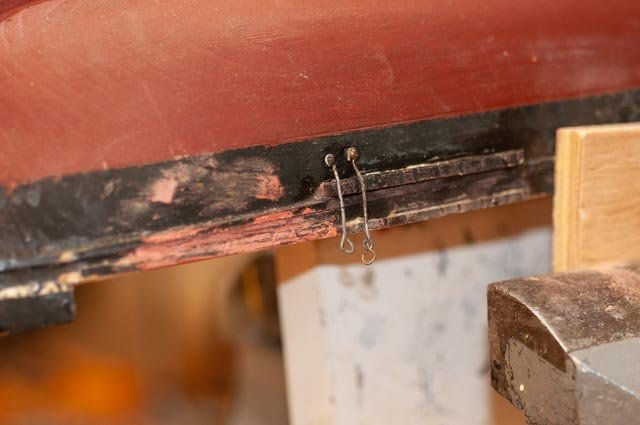 Here you see the dead eyes wire loops were wrapped with like No 17 brads.
Here you see the dead eyes wire loops were wrapped with like No 17 brads.
-
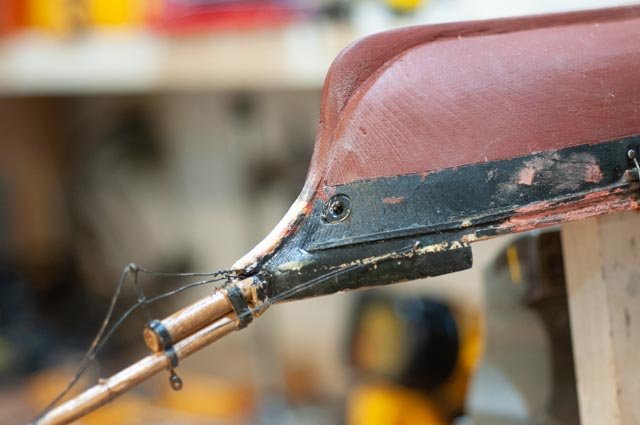 The figure head was a large clown…yes a clown… goneso. The record of Alna only listed the carved and gilded Billethead. so I will thicken the stem to form a billet and add some stick on tape with gold filligree
The figure head was a large clown…yes a clown… goneso. The record of Alna only listed the carved and gilded Billethead. so I will thicken the stem to form a billet and add some stick on tape with gold filligree
-
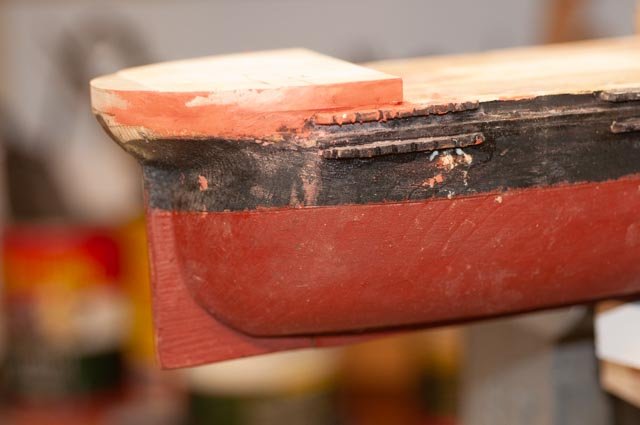 The stern was sort of round. Looking through Crother's book, there is a rounded stern that was typical of the era and listed to be on Alna. Also there was no poop deck. So after days of reading and thinking, we are adding a ½ poop deck based on Crothers findings.
The stern was sort of round. Looking through Crother's book, there is a rounded stern that was typical of the era and listed to be on Alna. Also there was no poop deck. So after days of reading and thinking, we are adding a ½ poop deck based on Crothers findings.
-
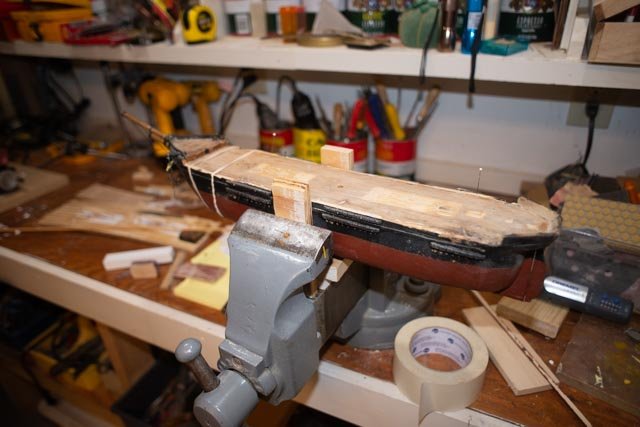 Here we have removed most everything and are cleaning up an under-deck. You can see the crudeness of the remaining bow and taft rails removed after this photo
Here we have removed most everything and are cleaning up an under-deck. You can see the crudeness of the remaining bow and taft rails removed after this photo
-
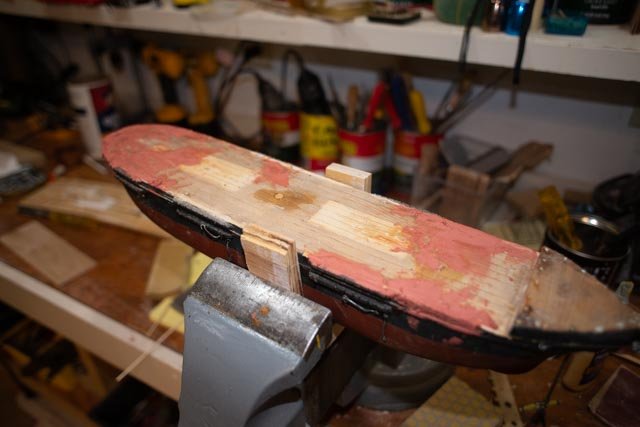 Here a little of the glazing putty to try to smooth out an under deck. there are at least 40 toothpick tips glued into old large brad holes to be sanded as well. When I laid out Alna masts, two matched perfectly an the mizzen within a 1/16. adding the half poop pushes the hole aft so we match there too. the fore deck extends aft and that is good because we gain an overhang
Here a little of the glazing putty to try to smooth out an under deck. there are at least 40 toothpick tips glued into old large brad holes to be sanded as well. When I laid out Alna masts, two matched perfectly an the mizzen within a 1/16. adding the half poop pushes the hole aft so we match there too. the fore deck extends aft and that is good because we gain an overhang
All for now
jon
- rek, mtaylor, michael mott and 3 others
-
 6
6
-
-
It's time to bring Charlie out again. I plan to record this as the final chapter in Charlies build and use. Maybe then I will say...completely finished
This summer I plan to give a few lectures on the four masted schooners of Boothbay. Although Charlie was built in Bath in 1894 she is right there as to the size of the last several large schooners built here. The boom years were 1919-1921. During that spell, 10 Schooners were built right here.
Next fall and winter I plan for trying to organize a diorama showing one of the yards and two of the schooners. We shall be celebrating 100 years since the launching. That yard has been a great lobster wharf for many years. i will start that as a new post later this year and hope to get other folks to build buildings and the lay out.
Here I will update the repairs and completion activities to get Charles Notman ready to show off, and some of the highlights of the history of these schooners here in the harbor. If you go back to the first few posts in this log, i built Charlie to be a prototype. I had hoped to build two sailing versions and get them to sail in the harbor. The problem is they really do not sail well as RC. Therefore I will move on and try to get some normal two masted schooners to sail as there are many examples of the success they have in RC. Boothbay had many pinky schooners and a large sardine and off shore fishing fleet to chose from
My punch list consists of the need to:
-
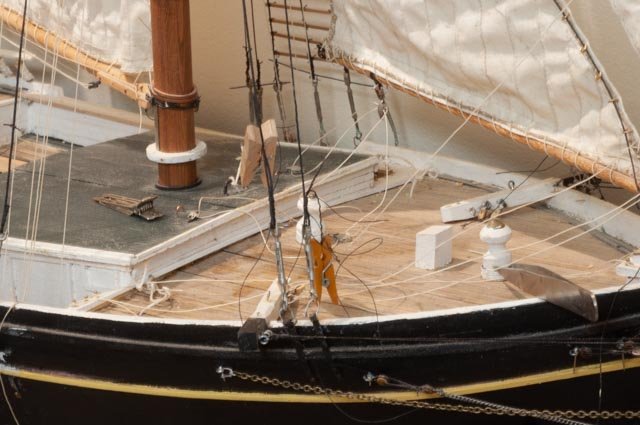 complete the starboard side shrouds.here i am splicing the first two of six to go.
complete the starboard side shrouds.here i am splicing the first two of six to go.
- complete starboard ratlines..ugh lots of them
-
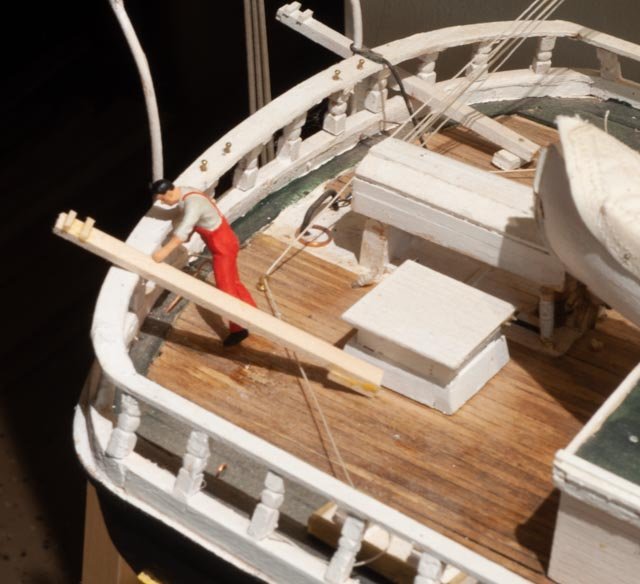 repair yawl boat and its broken support
repair yawl boat and its broken support
-
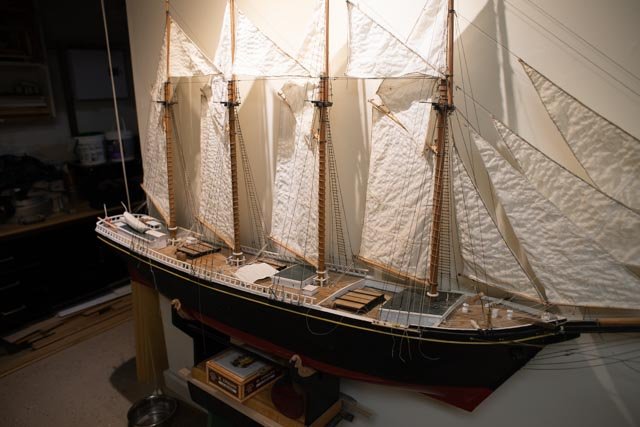 clean and clean.. wow the dust
clean and clean.. wow the dust
- try to coil and hang lines.
- add a few missing windows and cabin details
- repair several lose lines and broken chains
- figure out transport.
- complete some graphics for the display
-
complete power point lecture
In conclusion I will include a few visuals of a few schooners i am fixing up for the new museum store.
I believe just a little each day and it will be OK . I need to complete all by May
cheers
jon
-
-
post 35
dories part 2
I was determined to succeed where I have failed so many times before. Or better said ... I wanted to get the dories closer to what they should be. I remember being told by a master modeler that each time we start a new venture, we should expect to need to make 14 tries before getting a keeper. I am somewhere in the middle of that, so I do ask for some slack. The goal here is to spile some thin enough planks to bend at this small scale to make 16 foot [4 inch] non lapstrake dories. Let’s see how I did.
-
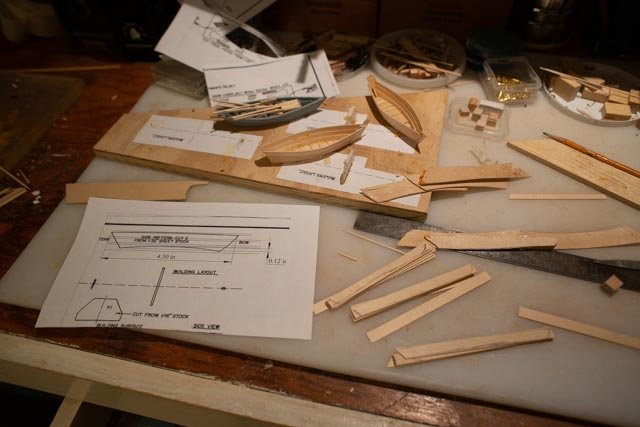 First of all, we look at the boat yard where the first dories in part one were made. We need to complete them for at least a stacking opportunity on another schooner. Second, we need to work around the shop to find planks that are thin enough to bend. the bass wood cut in this photo is just too stiff.
First of all, we look at the boat yard where the first dories in part one were made. We need to complete them for at least a stacking opportunity on another schooner. Second, we need to work around the shop to find planks that are thin enough to bend. the bass wood cut in this photo is just too stiff.
-
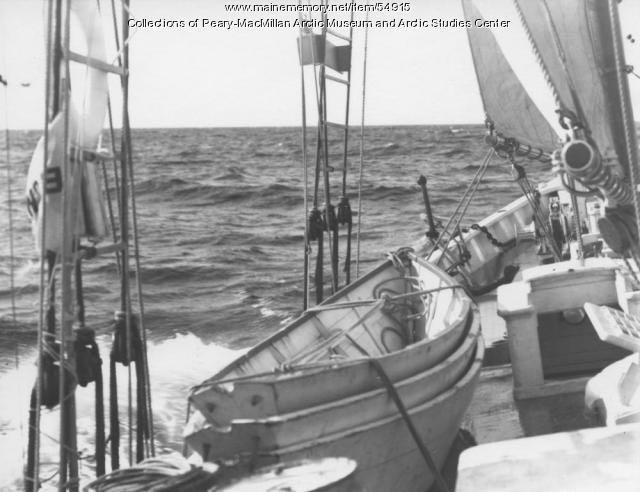 Here we see a friendly BRHS archive cropped photo showing clearly the later 1920’s dories. They were smooth and white with dark gunnels.
Here we see a friendly BRHS archive cropped photo showing clearly the later 1920’s dories. They were smooth and white with dark gunnels.
-
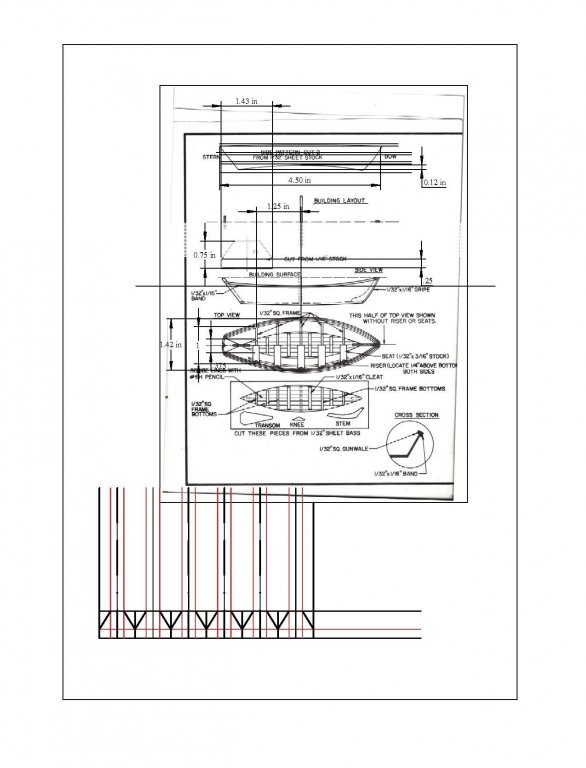 So back to turbo cad to lay out both midpoint molds and to figure out the spiling curves as best as I could. The third point molds ended up being simple dimensions to make up. I printed out a strip on the bottom of the sheet to lay out on a ¾ inch strip to make them all at once. All the horizontal lines on the top gave me a clew to figure out how to get planks just more than ¼” wide that would work.
So back to turbo cad to lay out both midpoint molds and to figure out the spiling curves as best as I could. The third point molds ended up being simple dimensions to make up. I printed out a strip on the bottom of the sheet to lay out on a ¾ inch strip to make them all at once. All the horizontal lines on the top gave me a clew to figure out how to get planks just more than ¼” wide that would work.
-
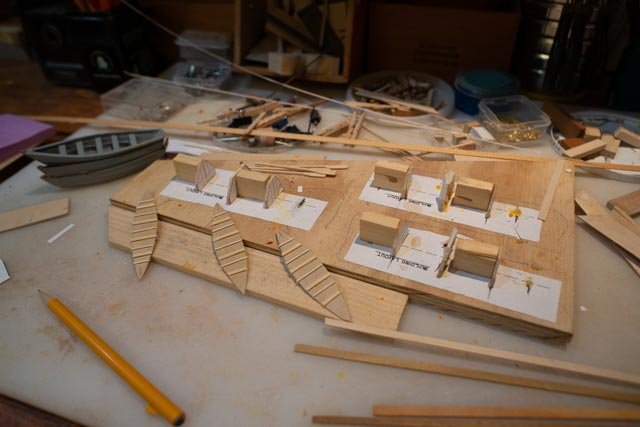 As I laid out all the molds, I added gunnels to the old dories and made up new bottoms and parts. I used 1/16” plywood to make them strong.
As I laid out all the molds, I added gunnels to the old dories and made up new bottoms and parts. I used 1/16” plywood to make them strong.
-
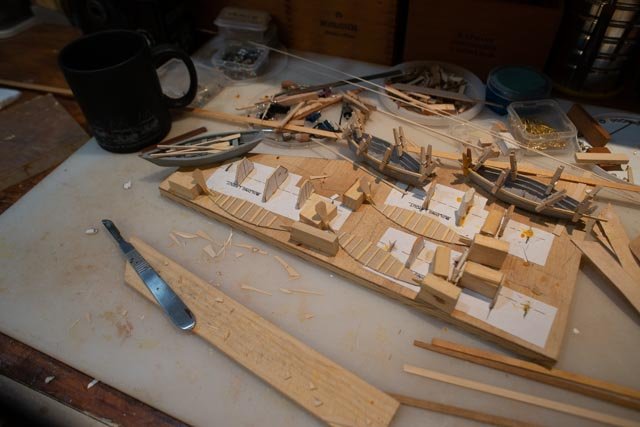 Here I am gluing up the transoms and stems as the gunnels set up on the old dories.
Here I am gluing up the transoms and stems as the gunnels set up on the old dories.
-
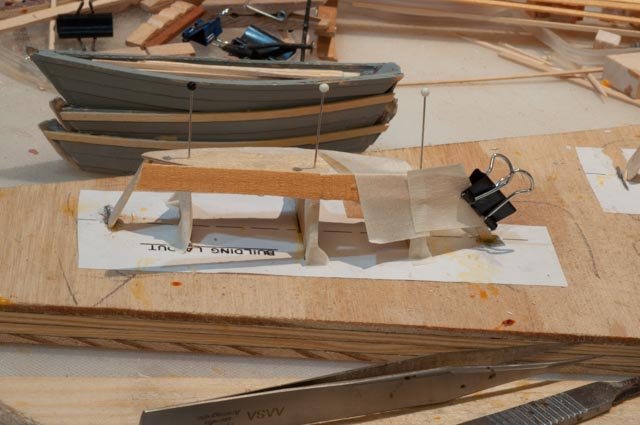 To make the proper flare we need to force the lower planks around the molds. Glue on the bow and let it set , then bend it around.
To make the proper flare we need to force the lower planks around the molds. Glue on the bow and let it set , then bend it around.
-
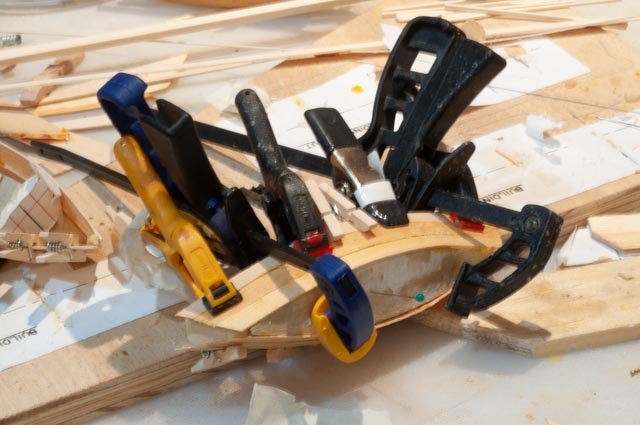 After setting two planks, I learned to remove the partially build dory from the molds [ this time using masking tape to allow breakaway. Then using every kind of clamp, I could work the top planks keeping the flare and making up the smooth[ish] joints.
After setting two planks, I learned to remove the partially build dory from the molds [ this time using masking tape to allow breakaway. Then using every kind of clamp, I could work the top planks keeping the flare and making up the smooth[ish] joints.
-
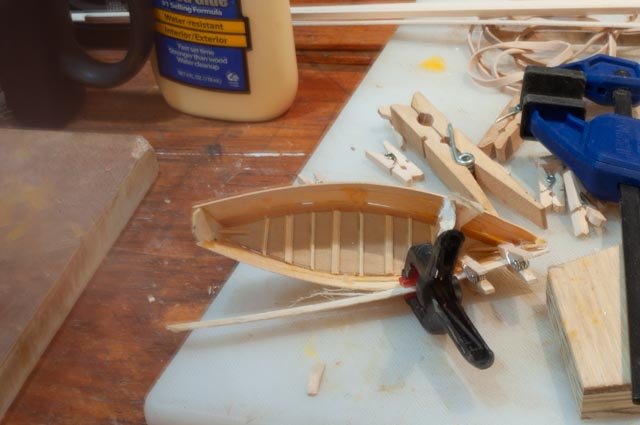 Here we glue to the bow stem before the bend
Here we glue to the bow stem before the bend
-
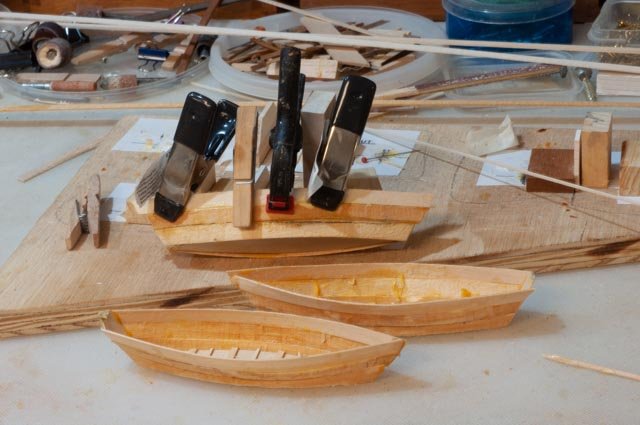 Another clamped third plank.
Another clamped third plank.
-
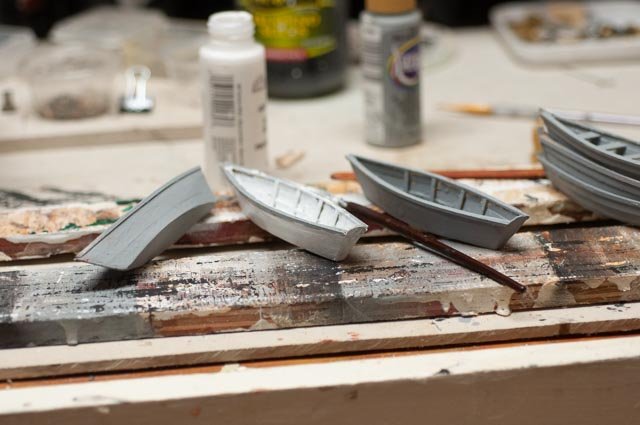 After glazing putty and sanding and setting the four ribs on the insides, we get a coat for gray for priming. Then more light sanding. The first one gets its first coat of white.
After glazing putty and sanding and setting the four ribs on the insides, we get a coat for gray for priming. Then more light sanding. The first one gets its first coat of white.
Diorama
-
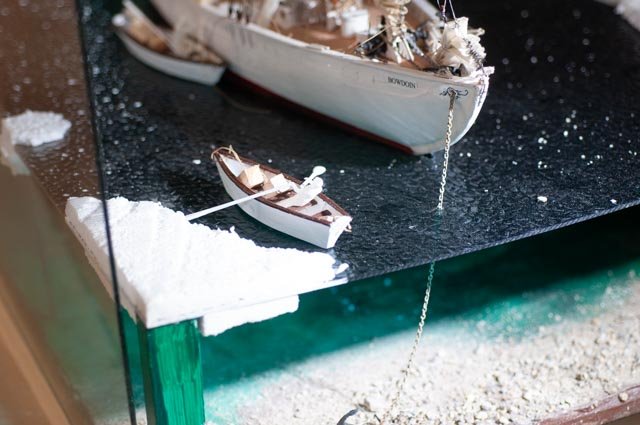 I have added a second dory under way to bring the last of the winter gear back aboard as we are a day or so at most from sailing. My figures only stand so I am figuring how to make his action reasonable.
I have added a second dory under way to bring the last of the winter gear back aboard as we are a day or so at most from sailing. My figures only stand so I am figuring how to make his action reasonable.
-
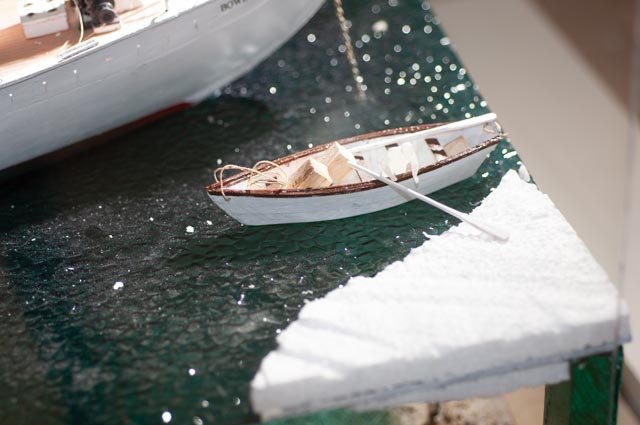 I am thinking of either a small line and anchor on the ice or just use the oar to hold position.
I am thinking of either a small line and anchor on the ice or just use the oar to hold position.
-
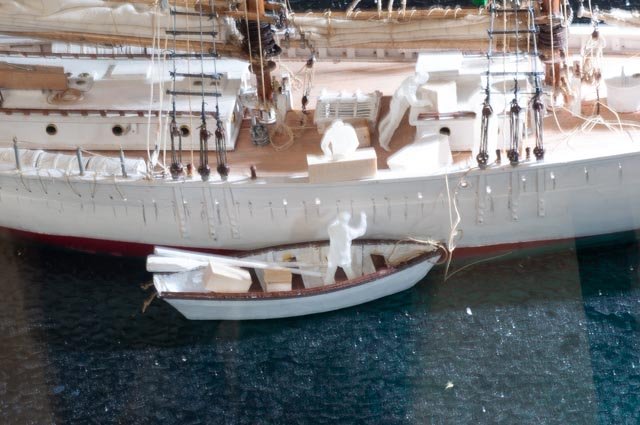 Here I have re staged the offloading of boxes and added two more figures. as of now i am not going to attempt to paint the figures. One reason not to paint them is their costumes are the correct period, but they are not sealskin, bear skin etc. I hope to encourage more support for opportunities like figure for the next diorama. There were 6 crew plus the Greenland and Labrador Inuit and dogs all getting ready to sail.
Here I have re staged the offloading of boxes and added two more figures. as of now i am not going to attempt to paint the figures. One reason not to paint them is their costumes are the correct period, but they are not sealskin, bear skin etc. I hope to encourage more support for opportunities like figure for the next diorama. There were 6 crew plus the Greenland and Labrador Inuit and dogs all getting ready to sail.
There is more cleanup and punch lists to do, lines to coil and hang and surely repairs between now and the show in May. I am already working on three other projects…so the beat goes on.
I will add a few more posts as we go to the show and I prepare the inevitable lecture. There will be some tours and review down at the Bowdoin college campus, where the MacMillan arctic museum display is always available. I still plan to visit the John Gardner model at Maine maritime and will add photos here. Finally i want to get the skipper over here and then find a way to ride on Bowdoin next summer.
Next up is back to an old build…Charles Notman to get ready for other summer shows.
All for now cheers
- Duanelaker, Tom E, ESF and 5 others
-
 8
8
-
-
Andrew
I love the look of the finished sheathing. The paint job is really crisp.
Cheers
-
Post 34
Diorama update
I was supposed to complete the dories by now but have had too many distractions. Working down the punch list I now have Bowdoin sitting in the glass box [ sideways so I call pull it out etc.] Here are some views showing where we are.
-
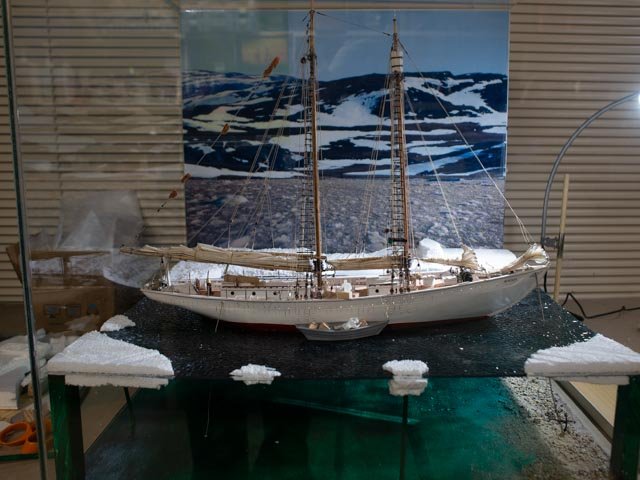 Here I fixed up the collage print to fit the box. It is just six sheets of normal printer paper scotch taped together. I am trying not to just add another $40 to go get it blown up , but may loose that argument
Here I fixed up the collage print to fit the box. It is just six sheets of normal printer paper scotch taped together. I am trying not to just add another $40 to go get it blown up , but may loose that argument
-
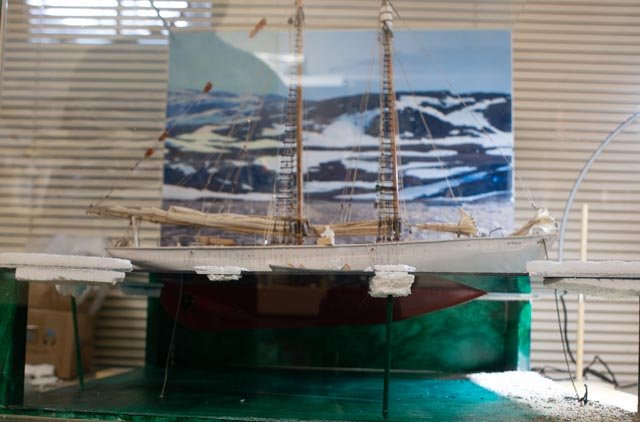 Here we see under water. The bow anchor on the beach [ poetic license as it would have been further forward] also there is an aft anchor line that runs down through the open water to water below. The ice is both above and below the water. I have learned that I should do ice differently underwater as it is different. I hope to visit the Maine Maritime Academy soon to see john Gardiners model where he did work on accurately depicting different types of ice. I hesitate to add more mixed blue color to the water. I hope to learn form artists this summer what to do to make it better next time.
Here we see under water. The bow anchor on the beach [ poetic license as it would have been further forward] also there is an aft anchor line that runs down through the open water to water below. The ice is both above and below the water. I have learned that I should do ice differently underwater as it is different. I hope to visit the Maine Maritime Academy soon to see john Gardiners model where he did work on accurately depicting different types of ice. I hesitate to add more mixed blue color to the water. I hope to learn form artists this summer what to do to make it better next time.
-
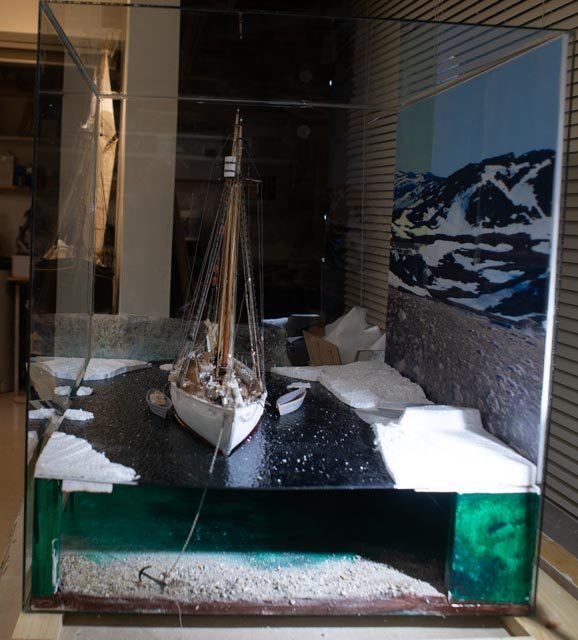 Here is the bow shot. Again, see the dark water looking down light. The anchor shows up well.
Here is the bow shot. Again, see the dark water looking down light. The anchor shows up well.
-
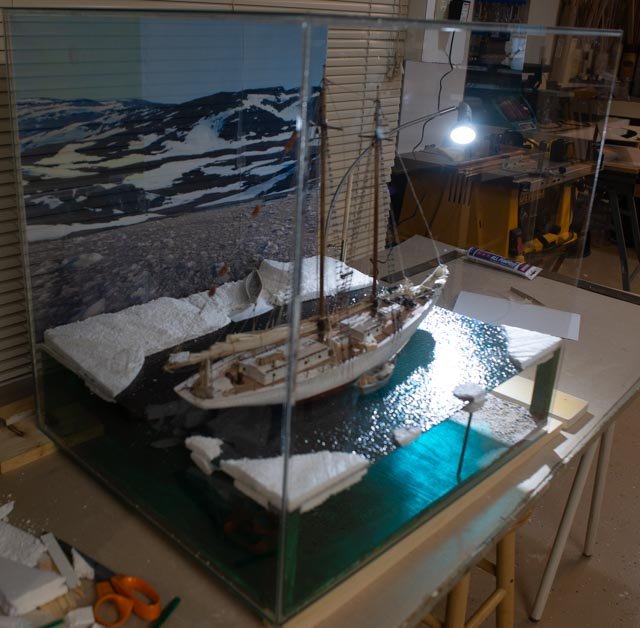 Now looking back into the light, we have active sparkling water
Now looking back into the light, we have active sparkling water
-
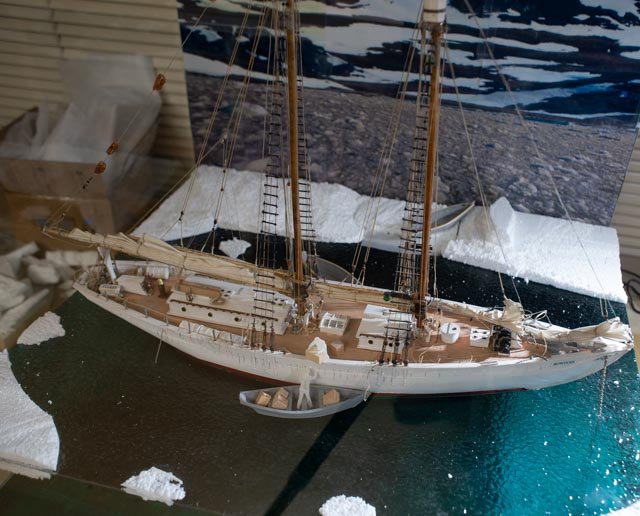 Here is the scene. This will be the story line. I talked about it before. As to the figures I am at a point where I have in the past used unpainted figures and believe I shall here too. The reason is the eye will go to the people if they are painted out and to the schooner if they are just there. How about that for a forum discussion. It is also another hobby area I have not yet entered, and I fear is a very slippery slope. Poorly painted figures may be worse than unpainted figures. I bought ten and there are only a few that will be on board. I may try one to see what happens, but later.
Here is the scene. This will be the story line. I talked about it before. As to the figures I am at a point where I have in the past used unpainted figures and believe I shall here too. The reason is the eye will go to the people if they are painted out and to the schooner if they are just there. How about that for a forum discussion. It is also another hobby area I have not yet entered, and I fear is a very slippery slope. Poorly painted figures may be worse than unpainted figures. I bought ten and there are only a few that will be on board. I may try one to see what happens, but later.
-
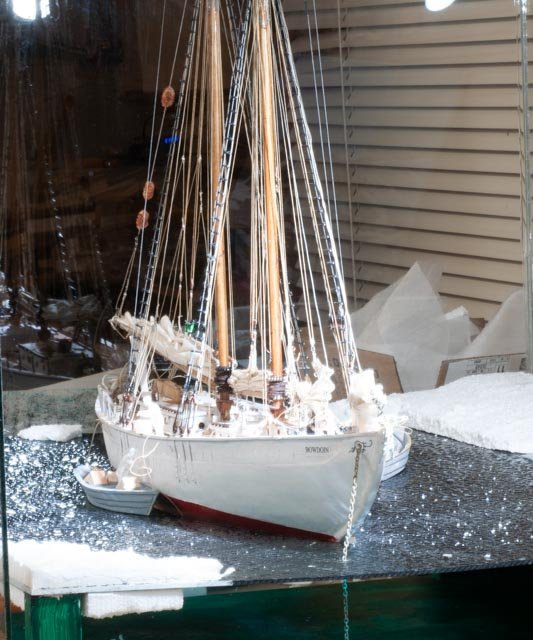 Here I add a close-up bow shot just because it is fun. With all the water and things, one might not notice there still is a punch list. All Lines are now on, but several are yet to the coiled and hung.
Here I add a close-up bow shot just because it is fun. With all the water and things, one might not notice there still is a punch list. All Lines are now on, but several are yet to the coiled and hung.
-
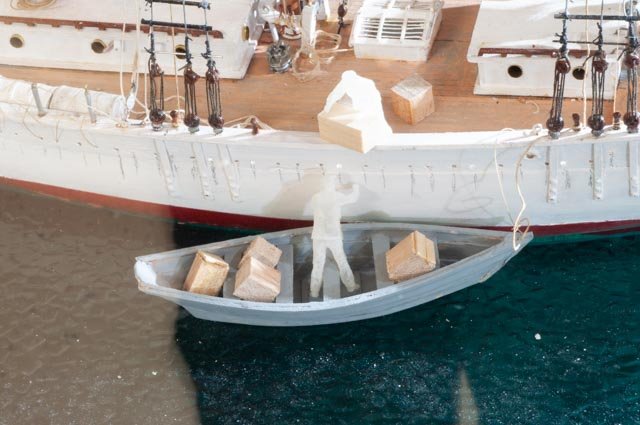 Here we have the proto-type dory for the last time. The replacements are now planked and in a week should be ready to launch. These lapstrake proto types will go to an early 1902 sardine schooner I built a few years ago in the same scale or to a friends 3/16 scale Bluenose where due to scale they are the right length.
Here we have the proto-type dory for the last time. The replacements are now planked and in a week should be ready to launch. These lapstrake proto types will go to an early 1902 sardine schooner I built a few years ago in the same scale or to a friends 3/16 scale Bluenose where due to scale they are the right length.
cheers
-
-
Gary thanks for the encouragement. experimentation is actually fun. It is amazing to try something and have it actually work. I am struggling but will succeed in making the dories correctly.
stay tuned
cheers
-
Post 33
Weekend update…getting near the end
As suggest in recent postings, there is a light at the end of this tunnel. A few more things are done, and we are now getting diverted into other items needed for the museum opening. Two large schooner models are coming next week for a quick clean up and discussion on casings. So, for the three or four outstanding areas of Bowdoin we have a little progress.
Hull and overall
During the travels many dogs lived on deck. The photos show obvious impacts out side of swabbing season.
-
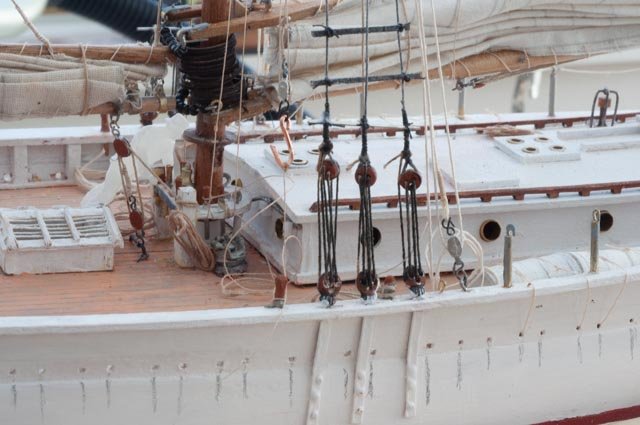 Here I have used soft pencil to show staining under the scuppers. Also I have complete the light brown under coat on all the blocks, dead eyes and pins. I will come back now with the dark brown cover up. The missed spots again showing some ware.
Here I have used soft pencil to show staining under the scuppers. Also I have complete the light brown under coat on all the blocks, dead eyes and pins. I will come back now with the dark brown cover up. The missed spots again showing some ware.
-
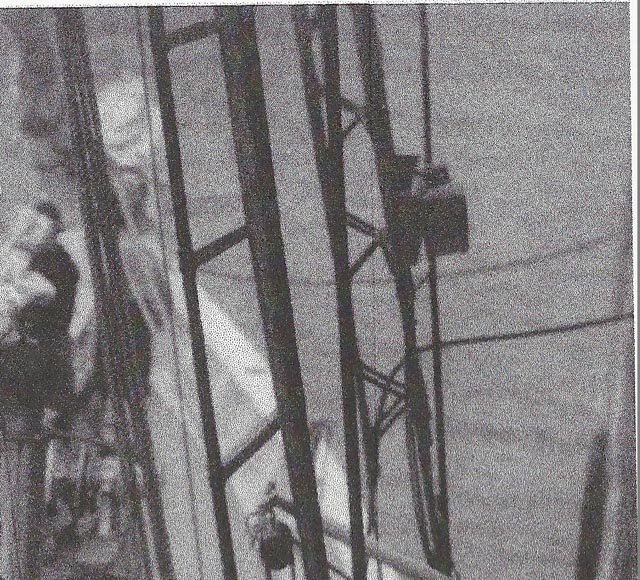 I studied the running lights and found they are not like the standard fishing schooner. In this BRHS archive photo [ and a few other views] , there was a single board about 8 inches wired up high between the 15-inch ratlines to allow feet to find there way. The lamps were then suspended. Talking with Bluejacket, they sent me some lanterns to try out.
I studied the running lights and found they are not like the standard fishing schooner. In this BRHS archive photo [ and a few other views] , there was a single board about 8 inches wired up high between the 15-inch ratlines to allow feet to find there way. The lamps were then suspended. Talking with Bluejacket, they sent me some lanterns to try out.
-
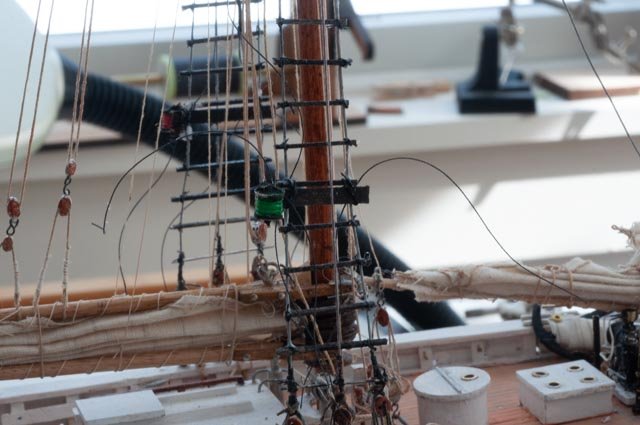 Here we see the results. The sewing lines still setting up and ready to trim
Here we see the results. The sewing lines still setting up and ready to trim
Deck and rigging.
I met again with Capt Will and we went over more details and suppositions. He supported that they would have had the turnbuckle and chain on the boom until they first sailed. I like that because making turnbuckles can be easier that getting lines through those tiny 1/8 block beckets.
-
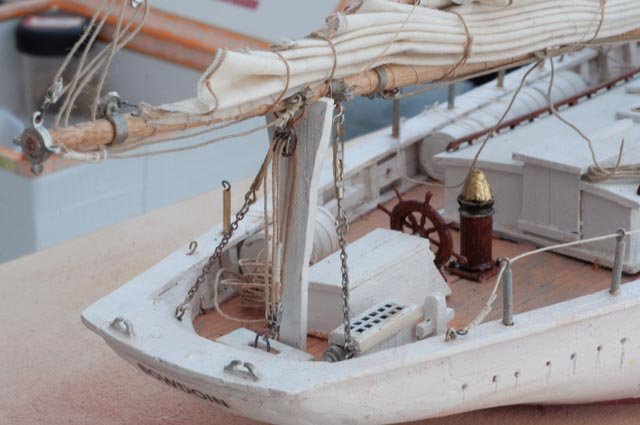 Here we see chains in place hold the boom rigid against the crutch. Also, a little brass paint to brighten up the binnacle in honor of the ready departure home.
Here we see chains in place hold the boom rigid against the crutch. Also, a little brass paint to brighten up the binnacle in honor of the ready departure home.
-
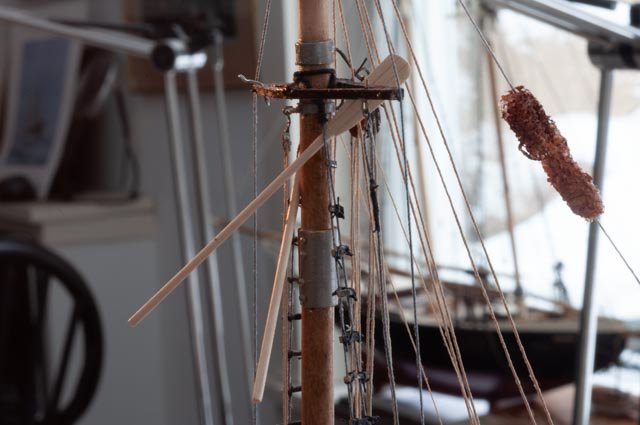 Here we in final inspection I really needed to get one more slat in the ratlines. The dory oars were handy to make the spread in the shroud. Lesson learned on the length of the splice. Oh well those who read this will know.
Here we in final inspection I really needed to get one more slat in the ratlines. The dory oars were handy to make the spread in the shroud. Lesson learned on the length of the splice. Oh well those who read this will know.
-
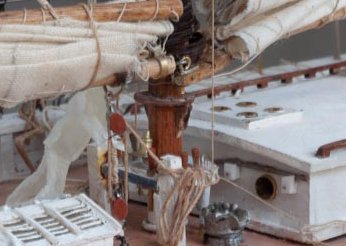 Here I have installed the pump handles. I made them once and lost them, so a quick remake was needed. Also, the bell is in place. I chose to remove the crutch because it would be very hard to see and the bell crowds the crutch. ....my excuse is weak......they are about to sail.
Here I have installed the pump handles. I made them once and lost them, so a quick remake was needed. Also, the bell is in place. I chose to remove the crutch because it would be very hard to see and the bell crowds the crutch. ....my excuse is weak......they are about to sail.
Diorama
-
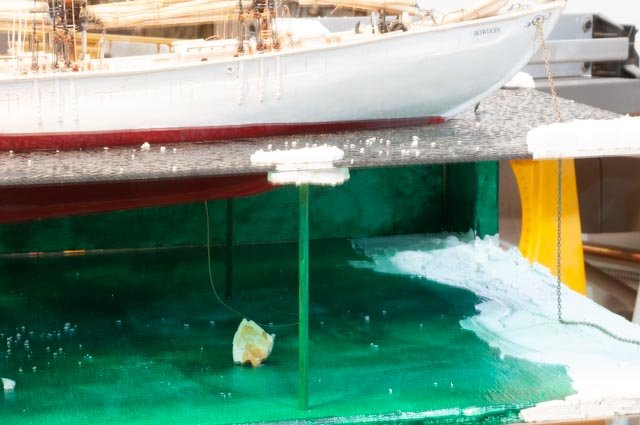 I need a few supports to keep the acrylic flat. I chose to paint out some small dowels the same color as the water. I then buried them in a small ice formation. I am not sure if that highlights them, so some artist advice may suggest I move them to be less noticeable.
I need a few supports to keep the acrylic flat. I chose to paint out some small dowels the same color as the water. I then buried them in a small ice formation. I am not sure if that highlights them, so some artist advice may suggest I move them to be less noticeable.
-
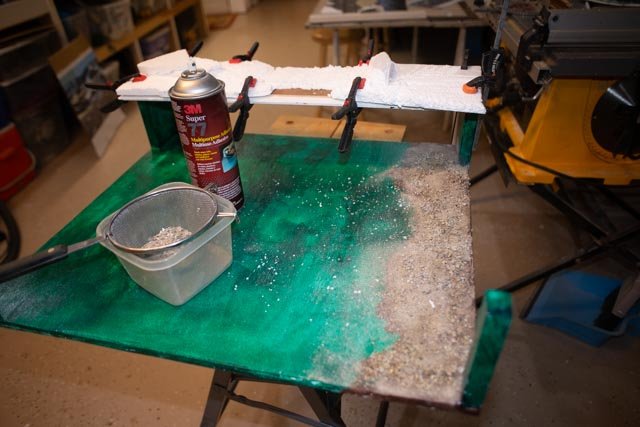 The Bowdoin was in close to the beach. There was a ten-foot average tide. In this view with the added beach they are in 18 feet of water. I felt that was reasonable enough to replicate their position in Refuge bay. Here you see the result. I dabbled with two brushes, medium gray and dark brown to create the background color. I then sprayed adhesive and dropped in separate sand and small pebbles. I did two layers and it looks OK to me. My critics say I need to sink the anchor in…..I think if it sits on top, it is easier to see.
The Bowdoin was in close to the beach. There was a ten-foot average tide. In this view with the added beach they are in 18 feet of water. I felt that was reasonable enough to replicate their position in Refuge bay. Here you see the result. I dabbled with two brushes, medium gray and dark brown to create the background color. I then sprayed adhesive and dropped in separate sand and small pebbles. I did two layers and it looks OK to me. My critics say I need to sink the anchor in…..I think if it sits on top, it is easier to see.
Dories update next time
Cheer
-
-
Post 32
Getting names on the hull
Naming is always a fun area. Thank goodness for computers and peel and stick. On previous builds I did all the work in Turbo Cad and then using layers could print white on black for black hulls. This time the hull is white so all I need is font and size.
For the filigree [ or what ever it is called] around the the anchor hawser pipe, I used the Bluenose method. I took a photo and pasted it into Turbo Cad. I then scaled it to full size. I then locked it and added a layer. I traced all the lines. Before I got to the formatting, I went through the names and figured it would be easier just to switch to MS Word. I transposed the fine line filigree to word and just covered it over with thicker lines. That smoothed out the curves. The whole thing is small at this scale, so I did not get carried away. The lettering was a little harder. I wanted to stretch the spacing just a bit but word does not seem to do that[ or better said I do not know how to do that]…I found a font that was close and printed out a few sizes
-
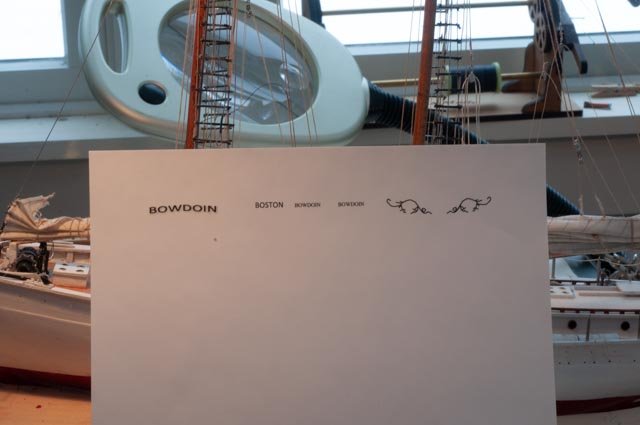 Here is the first attempt. The filigree was the right size, so I went ahead and printed it on peel and stick
Here is the first attempt. The filigree was the right size, so I went ahead and printed it on peel and stick
-
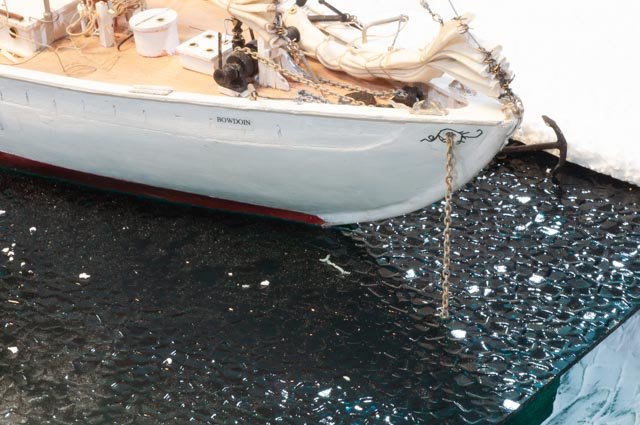 Here the filigree is on and the anchor chain re fitted. The name was to small, so I decided to put it on aft of the right location and then do some samples.
Here the filigree is on and the anchor chain re fitted. The name was to small, so I decided to put it on aft of the right location and then do some samples.
-
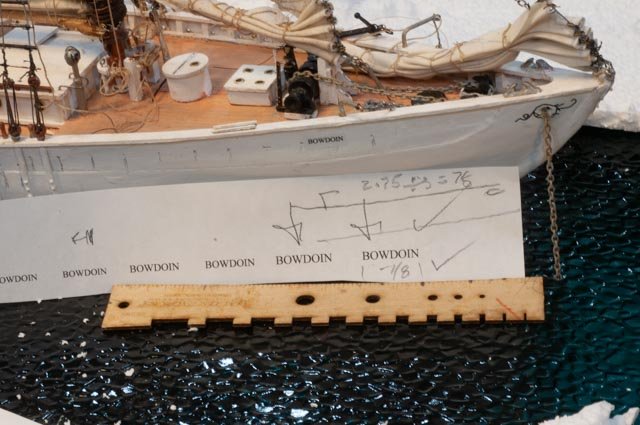 Here I am choosing the right size for the forward name board
Here I am choosing the right size for the forward name board
-
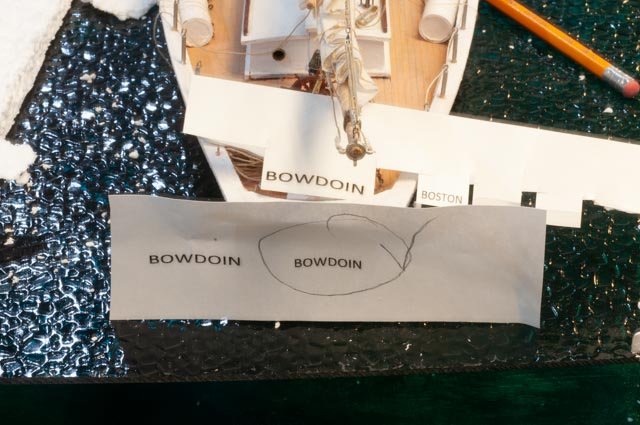 Here we are checking it out for the transom.
Here we are checking it out for the transom.
-
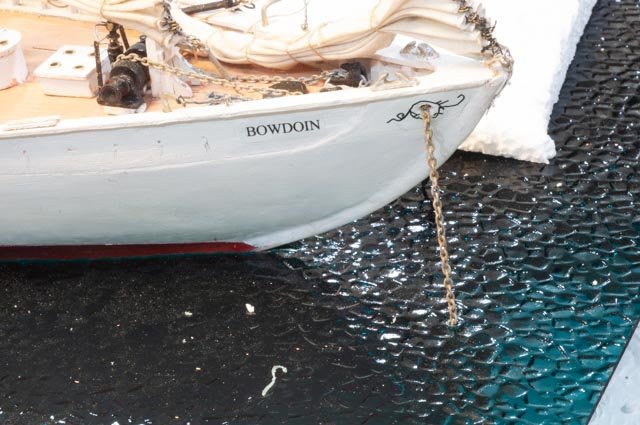 Here is the forward name board. I would love to be able to stretch it with out thickening the letters. even it cad it did that to me. You can see i have drilled the acrylic for the anchor
Here is the forward name board. I would love to be able to stretch it with out thickening the letters. even it cad it did that to me. You can see i have drilled the acrylic for the anchor
-
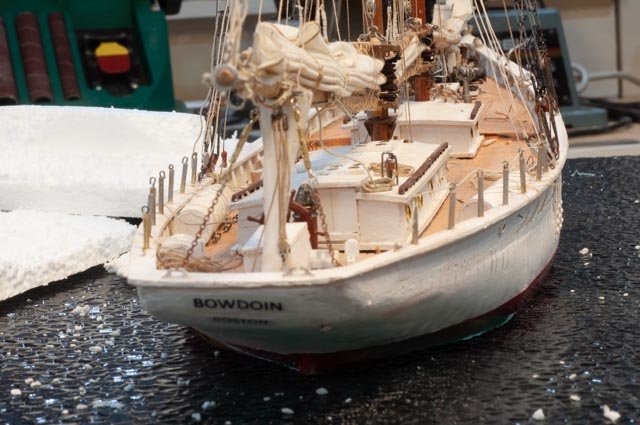 Here is the transom. In the early days she hailed from Boston.you can see the pencil lines of over winter drain stains under the scuppers.
Here is the transom. In the early days she hailed from Boston.you can see the pencil lines of over winter drain stains under the scuppers.
all for now
Cheers
-
-
Post 31
Diorama : the first look…..time to decide
I put everything together to see what I have and if I think I can make it work. I bought a glass box with ID to be 24 wide, 21 deep and 24 high. I set it on its side so I could slide things in and out to experiment. I set some trim planks under as I shall attach them to the ply wood base to receive the glass. I will likely put weather striping all around to soften the glass seat. On the exterior I have an extended plank with a dowel to hold the display lamp [ our morning sun]. We laugh at that a bit as the sun is in its 24 hour mode this time of year , so morning sun is a concept. I have the schooner facing east, the beach, so I guess it all makes sense.
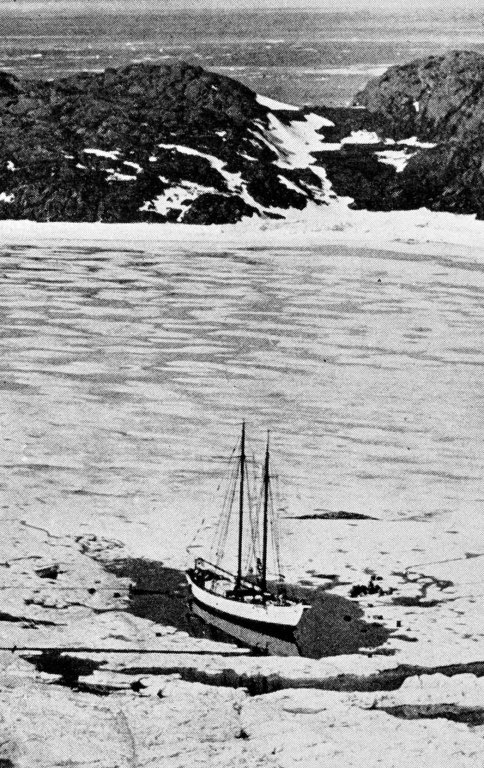 As a reminder this is the view from which our diorama is based. I bought this image on line. The story will be posted with sequential pictures. For the diorama we state:
As a reminder this is the view from which our diorama is based. I bought this image on line. The story will be posted with sequential pictures. For the diorama we state:
- BOWDOIN in morning light in July 1924. Using ash from the wood stove and sand from the beach on the ice, the sun melted around the Schooner as well as a way out of Refuge bay where they had just spent over 300 days frozen in ice, the crew readies her to go home.
- All fuel and most supplies were taken about fifty yard off the bow to the beach for safety. As part of the expedition, a structure was built primarily to set up equipment to measure the changes over time in the magnetic pole. A Marconi aerial was set on the mast tops and a radio was set on board to have transmitted the first arctic radio to talk to the world. The crew enjoyed listening almost every day.
- Before melting the ice, the crew had to fill the hold with stone ballast from the beach to replace the weight of the supplies brought north for the long winter. Some fifty dogs and several Inuit helpers will be taken home as Bowdoin sails south.
let's see it......
-
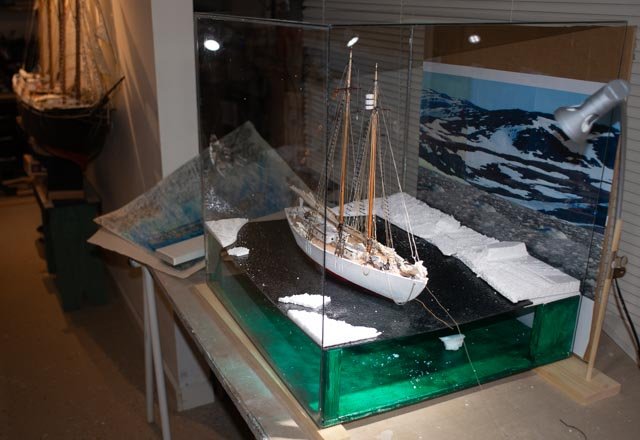 So here we have the first of three views if one is walking by the display. You are looking down sun, so the water is flat and the hull and rigging picking up direct light. The box is all painted out a dabbled green at the moment. I bought some blue but want some artist advise as sometime leaving it simple is the best advice. Whwere you see the light green strip of about 3 inches is now spackled out and becoming under water shore line holding the anchor.
So here we have the first of three views if one is walking by the display. You are looking down sun, so the water is flat and the hull and rigging picking up direct light. The box is all painted out a dabbled green at the moment. I bought some blue but want some artist advise as sometime leaving it simple is the best advice. Whwere you see the light green strip of about 3 inches is now spackled out and becoming under water shore line holding the anchor.
-
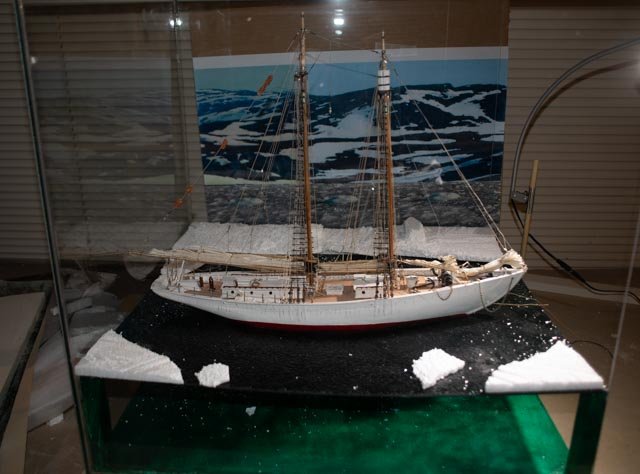 Walking on center we shall see the crew using the dories to ferry the last of the supplies on board before sailing. They should be properly on the port side [ dory tackle location if needed] . I believe I will move them around to the starboard viewed side s in last dory post. Future postings coming as I need to paint up a dory to check it out.
Walking on center we shall see the crew using the dories to ferry the last of the supplies on board before sailing. They should be properly on the port side [ dory tackle location if needed] . I believe I will move them around to the starboard viewed side s in last dory post. Future postings coming as I need to paint up a dory to check it out.
-
 What I love is this changing light as we move aft and see the effect of sun sparkling on the water, dark shadows on deck and back lighting of the rigging.
What I love is this changing light as we move aft and see the effect of sun sparkling on the water, dark shadows on deck and back lighting of the rigging.
You can see my amateur collage in the back ground. The two photos are cropped arctic views to try to depict the far shore as see in the first over view, taken from a comparable hill top on the south side of Refuge Bay.
Coming up
Getting names and things on the hull
Completing about ten more lines in the rigging
The bell and running lights, the anchor through the water
Completing the box and its base.
Building up the underwater shore near the beach, making the ice look better and adding supports to flatten the water.
Resizing the collage on foam core to site inside the glass.
And the dories
cheers


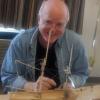

Bowdoin by Jond - FINISHED - BlueJacket Shipcrafters - 1:48 - DIORAMA
in - Kit build logs for subjects built from 1901 - Present Day
Posted
Nick
thank you for you r comments and support to the figures. I am putting together the final imaging and have posting to day of the updated diorama. I still plan to get up that way this season. My knee is almost back to normal so it should be soon.
regards
jon